WHAT’S NEXT IN CONVENIENCE AND FUEL RETAILING



WHAT’S NEXT IN CONVENIENCE AND FUEL RETAILING

INSIGHTS FROM OUR 2023 FOODSERVICE STUDY
































WHAT’S NEXT IN CONVENIENCE AND FUEL RETAILING

INSIGHTS FROM OUR 2023 FOODSERVICE STUDY




































THE CONVENIENCE RETAIL CHANNEL IS REACHING A TURNING POINT.






















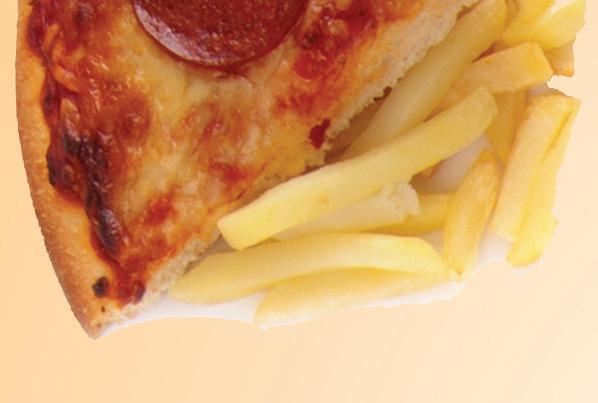






















CONVENIENCE STORE NEWS held its first-ever Foodservice Roundtable in June 2006. The inability to commit to foodservice was a key point discussed by the retailers and suppliers in attendance.
At the event, retail management consultant Sol Glastein, former owner of Simon’s Markets, recalled saying in 1983 that foodservice represented the future of the c-store industry. “But we, [as an industry], haven’t committed on a consistent basis,” he told the assembled group. “What aspect of foodservice can we reasonably accomplish?
We need to figure out what’s right for our stores in our markets, and it requires a foodservice culture to do that.”
In the past 17 years, successful convenience store operators have not only committed to foodservice, but they’ve moved it to the forefront of their business. Industry-leading retailers are building new, bigger stores that make fresh food the first thing customers see when they walk through the door. They’re also investing significant time, money and resources in enabling customers to order food the way they want and obtain it the way they want — think online ordering, mobile ordering, curbside pickup, in-store pickup, delivery, seating and more.
Foodservice has become so integral to the c-store industry that the cover story of this issue (see page 40) rightfully poses the question: “No Foodservice, No Future?” When we asked this of industry veteran and now-foodservice consultant Jerry Weiner, who is credited with developing Rutter’s best-in-class foodservice program and proving that a convenience store can be considered in the same category as a restaurant, he told us: “I think now, more so than ever, you will need a high-quality food offering to have any success at all.”
The exclusive 2023 Convenience Store News Foodservice Study, the findings of which are also being unveiled in this issue (see page 54), back up this statement. While average c-store square footage has remained fairly consistent in recent years, the percentage of space allocated to foodservice increased 3 points since 2021. Eighty-five percent of the retailers surveyed in this year’s study expect their foodservice sales to increase in 2023, and more than three-quarters of retailers believe they’ll generate more foodservice profits this year.

If your c-stores aren’t food forward yet, what are you waiting for? A high-quality, distinctive foodservice program is no longer a want-to-have, it’s a must-have for survival.

For comments, please contact Linda Lisanti, Editor-in-Chief, at llisanti@ensembleiq.com.


Ray Johnson Speedee Mart
Ruth Ann Lilly GPM Investments LLC

Vito Maurici McLane Co. Inc.
Jonathan Polansky Plaid Pantries Inc.
Greg Scriver Kwik Trip Inc.
Roy Strasburger
StrasGlobal
Co.
Chris Hartman Rutter’s
If your c-stores aren’t food forward yet, your time for success may be running out














SMART RETAILERS keep abreast of trends in other trade channels as well as their own. You never know where you might find a golden opportunity for growth.
I read this in Supermarket Guru Phil Lempert’s “Weekly Food Insights” newsletter last month: “What we’ve seen during the pandemic is a lot of fast-food restaurants, obviously their sales from drive-thru have increased dramatically. Sales of the restaurant people dining in are down about 16 percent, and 39 percent of all sales at a fast-food restaurant goes through the drive-thru. So, guess what they’ve decided to do? Let’s get rid of in-store dining.”
Apparently, according to Lempert, many fast-food chains have decided to reallocate their in-restaurant dining space to put in more drive-thru lanes. They also justify reducing in-restaurant dining as a cost-savings from not having to spend on the labor to keep the space clean. “It’s a way to get, you know, bottom line is more money per burger that you sell,” said Lempert.
He warns that this thinking could backfire on them. Lempert notes that even if 39 percent of your sales go through your drive-thru, that means 61 percent are from people who are coming into your restaurant and sitting there. “I think that it’s a knee-jerk reaction the same way we saw with 15-minute delivery,” he said. “Probably, in two or three years, all these fast-food restaurants are gonna have to go back to built-in seating.”
I agree with Lempert, for another reason. Fast-feeders could lose more market share to food-forward convenience store retailers if they reduce their in-restaurant dining space. According to the 2023 Convenience Store News Foodservice Study, 48 percent of convenience stores currently offer in-store seating, while 38 percent provide some kind of outdoor dining area. The study also revealed that another 8 percent of c-store retailers plan to add outdoor seating in the near future, and 8 percent said they plan to add indoor seating areas this year.
If, as Lempert predicts, more fast-feeders reduce or eliminate indoor dining, I have to think that smart c-store retailers will increase indoor and outdoor dining options at an even faster rate than stated in this year’s research.
When I travel the country by automobile, I always try to stop at convenience store retailers that have an excellent reputation for quality, fresh food. I’m seldom disappointed. But, when I am, it’s usually more related to the ambiance of the experience than the actual taste of the food. C-store retailers know they must have spotlessly clean restrooms, yet I still see too many who are lax in the upkeep of their indoor dining areas. Almost as bad is when I have to eat in my car and get ketchup and crumbs all over my shirt and lap.
If fast-feeders abandon inside dining, convenience stores should step up and fill the void.
For comments, please contact Don Longo, Editorial Director Emeritus, at dlongo@ensembleiq.com.

If fast-feeders abandon inside dining, convenience stores should step up and fill the void.














FEATURES
COVER STORY
40 No Foodservice, No Future?
The convenience retail channel is reaching a turning point.





DEPARTMENTS
E DITOR’S NOTE
4 What Are You Waiting For?
If your c-stores aren’t food forward yet, your time for success may running out.




VIEWPOINT
6 Reduced Inside Dining Will Backfire on Fast-Feeders C-stores would be wise to expand indoor and outdoor dining options.


14 CSNews Online


26 New Products


SMALL OPERATOR
34 A Place to Congregate
Foxtrot mixes the modern convenience store with a neighborhood café, encouraging consumers to stay awhile.
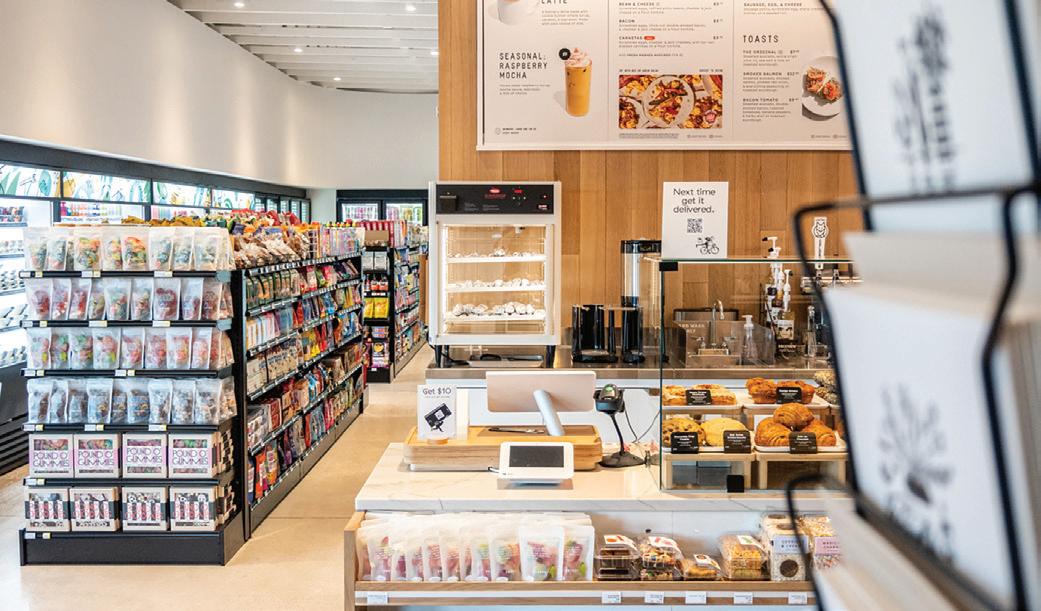
AN EYE ON D&I
76 Can Supporting Social Issues

Translate to More Customers?
EthniFacts research reveals one generation is the most likely to buy based on this factor.
STORE SPOTLIGHT
78 Food, Fuel & Fun
The next iteration of Fuel City’s convenience stores advances the company’s “Where Dreams Come True” slogan.


INSIDE THE CONSUMER MIND
98 Hitting the Road
The need to fuel up remains a strong trip driver for the convenience channel.




16 Maverik to Nearly Double Footprint With Kum & Go Acquisition

18 Love’s Embarks on a $1B Strategic Remodel Initiative
20 Fast Facts
20 Eye on Growth
22 Retailer Tidbits
24 Supplier Tidbits
TECHNOLOGY

74 Digging Into the Data
Gaining insights can improve the c-store shopping experience, from inventory to marketing and everything in between.
CATEGORY MANAGEMENT
FOODSERVICE STUDY
54 The Future Is Served Challenges persist, but c-store retailers are enthusiastic about the foodservice category.
TOBACCO
62 The Tobacco Playbook
A guide to the multiple regulation and litigation matters that stand to impact c-stores.

CANDY 66 Future-Proofing the Impulsivity of Candy Shopper engagement and mission-based merchandising are key to growth.
SNACKS
70 Snacking on Their Terms
Today’s consumers are willing to indulge in foods that spark joy and enhance their wellbeing.
8550 W. Bryn Mawr Ave., Ste. 200, Chicago, IL 60631 (773) 992-4450 Fax (773) 992-4455 WWW.CSNEWS.COM
BRAND MANAGEMENT
SENIOR VICE PRESIDENT & GROUP BRAND DIRECTOR Paula Lashinsky (917) 446-4117 - plashinsky@ensembleiq.com
EDITORIAL
EDITOR-IN-CHIEF Linda Lisanti llisanti@ensembleiq.com
EXECUTIVE EDITOR Melissa Kress mkress@ensembleiq.com
SENIOR EDITOR Angela Hanson ahanson@ensembleiq.com
MANAGING EDITOR Danielle Romano dromano@ensembleiq.com
ASSOCIATE EDITOR Amanda Koprowski akoprowski@ensembleiq.com
EDITORIAL DIRECTOR EMERITUS Don Longo dlongo@ensembleiq.com
CONTRIBUTING EDITORS
Renée M. Covino, Tammy Mastroberte
ADVERTISING SALES & BUSINESS
ASSOCIATE BRAND DIRECTOR & NORTHEAST


SALES MANAGER Rachel McGaffigan - (774) 212-6455 rmcgaffigan@ensembleiq.com


ASSOCIATE BRAND DIRECTOR & WESTERN SALES MANAGER Ron Lowy - (330) 840-9557 - rlowy@ensembleiq.com

ASSOCIATE PUBLISHER & MIDWEST SALES MANAGER Kelly Fischer - (773) 992-4464 - kfischer@ensembleiq.com
ACCOUNT EXECUTIVE & CLASSIFIED ADVERTISING Terry Kanganis - (201) 855-7615 - tkanganis@ensembleiq.com
CLASSIFIED PRODUCTION MANAGER Mary Beth Medley (856) 809-0050 - marybeth@marybethmedley.com
DESIGN/PRODUCTION/MARKETING
SENIOR CREATIVE DIRECTOR Colette Magliaro cmagliaro@ensembleiq.com
ART DIRECTOR Lauren DiMeo ldimeo@ensembleiq.com
PRODUCTION DIRECTOR Ed Ward edward@ensembleiq.com
MARKETING MANAGER Krista-Alana Travis ktravis@ensembleiq.com
SUBSCRIPTION SERVICES
LIST RENTAL mbriganti@anteriad.com
SUBSCRIPTION QUESTIONS contact@csnews.com
CORPORATE OFFICERS
CHIEF EXECUTIVE OFFICER Jennifer Litterick
CHIEF FINANCIAL OFFICER Jane Volland
CHIEF PEOPLE OFFICER Ann Jadown
CHIEF STRATEGY OFFICER Joe Territo
CHIEF OPERATING OFFICER Derek Estey
































































CSN has been sharing the dynamic growth of Kombucha and the factors driving demand. Here GT Dave, founder and CEO of GT’s Living Foods pulls back the curtain on best merchandising practices and how-to bring attention to the category in stores.
Q: The demand for Kombucha is evident from sales trends. How can -stores build visibility of the products in stores?
A: In over 28-plus years of crafting raw Kombucha, I’ve seen it grow from a niche product that was only found in natural food stores to one of the largest categories within the functional beverage space. Following the Covid-19 pandemic, this momentum accelerated, and Kombucha is now outpacing Conventional Beverages growth by 8.1%. To build visibility, I encourage C-stores to embrace the “Better-for-You” movement by becoming early adopters of dedicated Health and Wellness beverage sections.

Q: How many brands and flavors should -stores carry to prove they are serious about the business?
A: There’s only one Kombucha leading the category, and that has always been SYNERGY. Sales trends dictate that the Health and Wellness category is deserving of more representation in C-stores, and we recommend carrying the most popular and most widely recognized Kombucha brand in the U.S. Our newest SYNERGY 10oz. bottles were created in our four most popular flavors — designed with -stores in mind.
Q: Where in the beverage department is the best location for presenting Kombucha?
A: As a leading beverage in the Health and Wellness category, we recommend positioning SYNERGY with other functional beverages like tea, cold-pressed juices, and ready-to-drink coffees. Creating an exclusive “Better-for-You” section meets the needs of current customers while highlighting your selection.
Q: What is GT Living Foods doing to market its brand and drive consumers to -stores?

A: When I first started GT’s Living Foods back in 1995, at 15
years old, I was the first person to bottle raw Kombucha. Today, we remain the category and market leader in Kombucha and Functional Beverages. Innovation is key to our growth and the launch of SYNERGY 10oz. bottles show that. This new offering provides consumers with an on-the-go option that meets their immediate consumption needs while still providing them with the GT’s quality they know and love!
Q: What other categories are typically purchased with Kombucha? Is there synergy with foodservice?



A: Our consumers are passionate about their health and wellness, and we’ve seen the most affinity among other items in the same category. We expect to see SYNERGY purchased with fruit, nuts, and other “Better-for-You” selections available at -stores.
Q: Are any new flavors in the works for 2023?
A: Our extensive portfolio provided several options for our SYNERGY-10oz. lineup, but we decided to focus on our best-selling fruit-forward flavors in this package size due to their mainstream appeal. We always have new flavors in the works, so there will be many delicious options on the horizon.
For more information on getting a bigger share of the $3.4 billion Kombucha market contact GT’s Living Foods, contact sales@drinkgts.com.

1
The fuel distributor and convenience retailer will use the Chapter 11 process to achieve a comprehensive restructuring that will strengthen the company’s fuel distribution business, dealer network and retail business.
2
Buc-ee’s and Sheetz Inc. are two convenience store chains that are successful in their regions and have grown into leading brands, according to a Placer.ai report. They are among 10 regional powerhouses that, although they have taken different approaches to expansion, are all well-positioned for future growth.
The retailer was named No. 1 on the Forbes Customer Experience All-Stars List and earned a spot on Insider’s list of highest-paid entry jobs in retail.
The company signed an agreement with ExxonMobil to acquire 64 Houston-area convenience stores and fueling facilities from the Landmark Group under the joint venture Spring Partners Retail LLC. If approved, Global Partners will act as the management company and operator.
Updating Loyalty Programs for the 21st Century Customer

To combat this, retailers must adapt to new methods of meeting consumers where they are and keeping them engaged. At the same time, they can utilize new technology to gain better customer knowledge while still protecting personal and private information. For more webinars, visit the Events & Webcasts section of csnews.com.
MOST VIEWED NEW PRODUCT
Dunkaroos Triple Chocolate
Hemant Kalbag, a managing director in Alvarez & Marsal’s Consumer Retail Group, believes dollar stores’ rapid expansion also reflects a general move toward value-oriented shopping seen across all income brackets. No matter what, convenience stores will need to address this issue and find new ways to appeal to customers.

General Mills Convenience Minneapolis generalmillscf.com (800) 243-5687














MAVERIK — ADVENTURE’S FIRST STOP is acquiring Kum & Go LC, a chain of more than 400 convenience stores across 13 states, from the Krause Group. As part of the deal, it will also acquire Solar Transport, a tank truck carrier and logistics provider.
The announcement follows reports earlier this year that Des Moines, Iowa-based Kum & Go was exploring all its options, including a sale. Financial terms of the transaction were not disclosed.
The combination of Maverik and Kum & Go will create a best-in-class convenience store operator across the Midwest and Rocky Mountain regions with a differentiated value proposition across fuel, foodservice and in-store offerings, according to the two companies.
Based in Salt Lake City, Maverik operates nearly 400 locations across 12 western states.

“We have long admired the Kum & Go brand. Kyle [Krause] and Tanner [Krause], and the generations before them, have built an exceptional business that pairs quality with convenience and puts people first,” said Maverik President and Chief Adventure Guide Chuck Maggelet.
“We are honored to carry their legacy forward as we build on Kum & Go’s strong operating and innovation capabilities and expand our adventurous convenience experience. We look forward to welcoming Kum & Go and Solar Transport associates and stores to Maverik — Adventure’s First Stop,” he added.
Established in Hampton, Iowa, in 1959, Kum & Go is a fourth-generation, family-owned chain. Kyle Krause led the business until 2018 when he handed the reins to his son, Tanner.
“This is the most momentous day in the 63-year history of our family business,” said Tanner Krause, current president and CEO of Kum & Go. “My family has worked for four generations to create and build Kum & Go into a business that has done an incredible amount of good for our people, for Iowa and beyond. Serving as president for the past five years has been the fulfillment of my lifelong dream.”
The transaction is expected to close in the coming months and is subject to customary closing provisions. BofA Securities and BMO Capital Markets Corp. served as financial advisors to FJ Management, Maverik’s parent company. Kirkland & Ellis LLP served as FJ Management’s legal advisor. J.P. Morgan Securities LLC served as financial advisor to Krause Group. Vedder Price served as Krause Group’s legal advisor.
IT’S NOW ILLEGAL IN CALIFORNIA TO SELL MOST FLAVORED TOBACCO PRODUCTS, INCLUDING VAPES AND MENTHOL CIGARETTES. FOLLOW THE LAW TO PROTECT KIDS FROM A LIFETIME OF DEADLY ADDICTION.

MAKE SURE YOU’RE FOLLOWING THE LAW AT NOFLAVORS.ORG

The company will identify 200 sites to upgrade based on foot traffic, sales and store age
LOVE’S TRAVEL STOPS is launching a $1 billion, five-year plan that will update 200 locations. On average, the company will invest between $2 million and $7 million per site through this Strategic Remodel Initiative.

“Investing in existing locations is another way Love’s prioritizes creating a first-class experience for customers,” said Randy Swain, director of construction and remodels for Love’s. “Being strategic with how we update existing locations — and keeping them open during the process — strengthens Love’s commitment to getting customers back on the road quickly.”
Once the renovations are completed, each updated location will feature a more modern look and be equipped with open-kitchen concepts, multiple restaurant options, and updated Love’s Truck Care and Speedco locations. Where space allows, dog parks will be added to those locations that do not currently have them.
Oklahoma City-based Love’s noted that while it has always invested in its locations, this Strategic Remodel Initiative is identifying which sites will be updated based on foot traffic, sales and store age. Sites that will soon be completed as part of the program are located in El Paso, Texas, and Columbia, Tenn.
The company also will update three locations this year via teardown and reconstruction as part of the initiative. These locations will be closed during the remodel process and reopen with an expanded footprint and new look and feel. Love’s locations in Oklahoma City and Gary, Ind., already reopened in February after being completely rebuilt.
In addition to the Strategic Remodel Initiative, Love’s plans to open 25 new locations this year. In total, the travel center operator will invest approximately $1 billion in new and remodeled locations in 2023, adding amenities and services to maintain its commitment to safe, clean and well-maintained locations, the company said.































































































$906.1B
Total U.S. convenience industry sales topped $906.1 billion in 2022, of which $302.8 billion was from in-store sales, equating to 33.4 percent.
— NACS
8%
At- and away-from-home food and beverage sales grew 8 percent in 2022, exceeding historical norms.
— Circana
74%
Seventy-four percent of baby boomers and 72 percent of Gen Z agree that they prefer to order menu items with locally sourced ingredients.
— Y-PulseShell USA Inc., a subsidiary of Shell plc, completed a $169 million acquisition of electric vehicle (EV) charging and media company Volta Inc. Shell now owns and operates one of the largest public EV charging networks in the United States.
part of the retailer’s remote store network. QT plans to continue expanding throughout the state, with an additional five stores scheduled to open in 2023.
Casey’s General Stores Inc. acquired DeliMart c-stores in the Iowa City, Iowa, area. The stores closed in late March and will reopen under the Casey’s banner.
Choice Market plans to rapidly scale its cashierless mini-mart format following the successful launch of the first Choice Mini-Mart, which debuted in October 2022 at The University of Colorado Anschutz Medical Campus.
Kent Kwik Convenience Stores entered into an asset purchase agreement to acquire Tom Thumb Food Stores Inc. The 14-store deal will bring parent company Kent Cos. to Florida.

Dash In unveiled a new convenience store in Chantilly, Va., featuring a reimagined store experience and a new menu. The 5,600-square-foot store also includes 17 fueling positions and a newly branded Splash In ECO Car Wash.
QuikTrip Corp. (QT) opened its first location in Mississippi. The Clinton site is

Rutter’s is making progress on its expansion plans with the opening of the company’s 85th store. Located in Orwigsburg, Pa., the 24-hour site measures more than 10,250 square feet and includes 14 fueling positions.
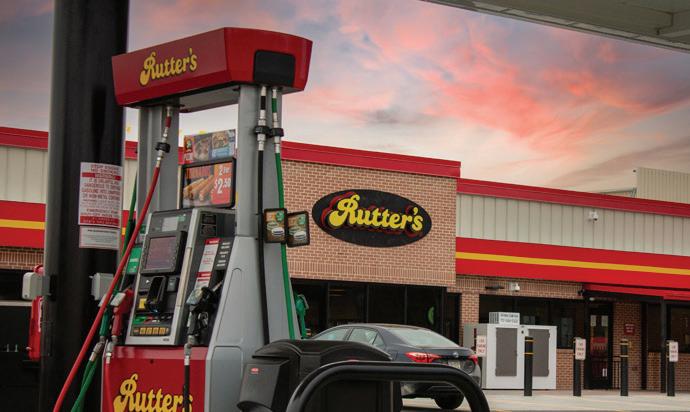


















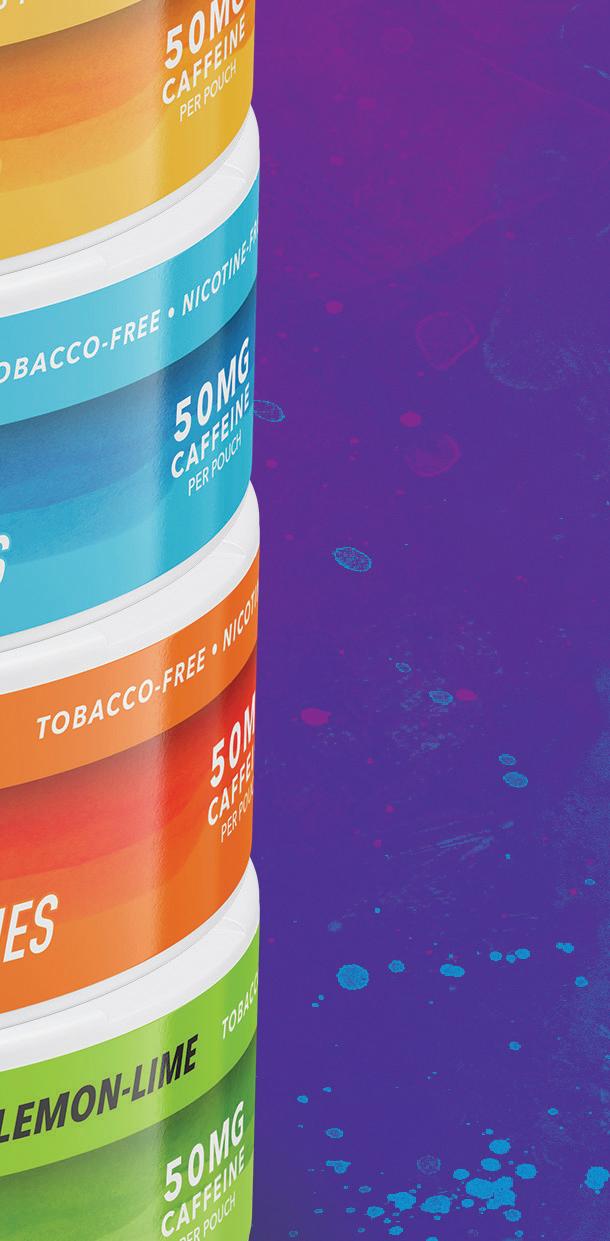






















































































































BP and Uber entered into a global mobility agreement to help accelerate Uber’s goal of becoming a zero-tailpipe emissions mobility platform by 2030 in the United States and by 2040 globally. BP will offer deals to drivers on the Uber platform.

Stewart’s Shops opened a Tesla Supercharger station at a convenience store in Ballston Spa, N.Y. The charger is capable of being used by either Tesla or non-Tesla electric vehicles with combined charging system compatibility.

GetGo Café+Market entered into a partnership with Bitcoin Depot Inc. The move will bring bitcoin ATMs to 125 GetGo Café+Market stores in multiple metropolitan areas.
Love’s Travel Stops hosted a two-day National Hiring Event in late March to hire 2,000 employees. Positions spanned the operator’s travel stops and truck care locations, as well as positions in its retread and contact centers.
GPM Investments LLC launched a new fas REWARDS mobile app. Updated features include exclusive deals not available in stores, order and delivery options, and age-verified offers on tobacco and alcohol.

























Hunt Brothers Pizza expanded its reach through distribution partner TBHC Delivers. The move brought the made-to-order pizza offering into western New York.


Frito-Lay North America made its first-ever third-party shipment on an electric vehicle (EV) with Schneider National Inc. This marks the first third-party transportation shipment on an EV for parent company PepsiCo globally.


Juul Labs Inc. will pay $462 million to New York, California, Colorado, Illinois, Massachusetts, New Mexico and Washington, D.C. as part of a settlement. The agreement settles claims the company marketed to youth.






Capital Candy Co. entered into a distribution agreement with SurgePays Inc. Under this pact, SurgePays can provide Capital Candy’s 3,000 customers with its full suite of prepaid telecom and fintech products.

Haribo of America Inc. selected Colle McVoy as its shopper marketing agency of record. The agency and 10 Thousand Design will create retail display graphics for key seasonal moments, as well as support larger promotional initiatives.


Self-checkout system Mashgin integrated with Shift4, a producer of integrated payments and commerce technology. The partnership allows retailers that use Mashgin to equip their points-of-sale with Shift4 payment processing.
National Retail Solutions (NRS) launched three new features: Find My Biz, Manage My Reviews and the NRS Loyalty Program. These features provide independent retailers with new resources to increase store visibility and on-demand delivery services.

The Hershey Co. brought back its limitededition Hershey’s SHE Bars for the third year. The brand and its nonprofit partner Girls on the Run curated more than 200 adjectives that were featured on the SHE Bar wrappers.

PDI Technologies acquired Blue Cow Software, a fuel oil and propane management software business. Under the deal, Blue Cow Software will divest from Repay Holdings Corp., a provider of vertically integrated payment solutions.



New from E-Alternative Solutions, Mojo Balanced Energy Pouches feature 50 milligrams of caffeine per pouch derived from coffee beans, as well as a proprietary blend of functional ingredients such as ginseng root, yerba mate, B vitamins and amino. Available in a wide range of flavors, including Caramel Mocha, Mint, Orange Burst, Lemon Lime, Berry and Mango, Mojo pouches are sugar free and have zero calories. Each can contains 15 pouches.
E-ALTERNATIVE SOLUTIONS • DARIEN, CONN. • EALTERNATIVESOLUTIONS.COM
The Hershey Co. is taking its famous candy brand in a new direction with Reese’s Dipped Animal Crackers, a new spin on the classic childhood snack. Available nationwide, the bite-sized animal crackers are covered in peanut butter candy and dipped in milk chocolate to evoke the classic Reese’s taste. Reese’s Dipped Animal Crackers are sweet and crunchy, creating the ultimate snack, according to the maker. The crackers come in 13 animal shapes, including lions and bears. Pricing is at the discretion of the retailer. THE HERSHEY CO. • HERSHEY, PA. • THEHERSHEYCOMPANY.COM



SweeTARTS Gummy Fruity Splitz are fruit-flavored poppable gummies that “split” into two sides to give gummy fans the best of both worlds: a sweet side and a tangy tart one, with a soft bouncy texture, according to the company. Each pack includes six flavors: Blue Punch, Cherry, Grape, Orange, Lemon and Apple. The suggested retail price for the 3.5-ounce bag is $1.09, while the 6-ounce package has a suggested price of $2.19. The new candy product is available nationwide.
FERRARA
Mars Inc. adds to its growing ice cream portfolio with the introduction of M&M’S Cookies and Cream Ice Cream Cookie Sandwiches. The product offers a multitexture experience, combining M&M’S chocolate candies, baked chocolate cookies, cookie pieces and creamy ice cream. The company seeks to bring the ice cream shop experience straight to consumers’ homes. M&M’S Cookies and Cream Ice Cream Cookie Sandwiches are available as singles or in packs of four, with nationwide availability. MARS INC. • NEWARK, N.J. • MARS.COM

ImageWorks Display unveils its latest merchandising solution, VAST. The gondola system has been designed from the ground up to meet the demands of modern retail. Custom uprights accommodate integrated electronics, allowing for shelving and headers to be illuminated with various lighting and digital signage options. Additionally, the system’s durable framework can accommodate a range of manufacturer shelving, making it ideal for any retail environment. The system comes with shelf markers that provide visual reference for easy planogram resets.
IMAGEWORKS DISPLAY • WINSTON-SALEM, N.C. • IMAGEWORKSDISPLAY.COM

Sixth-generation family business Unique Snacks expands its offering into new snack categories through the introduction of Puffzels. These gluten-free, vegan, non-fried, Non-GMO Project Verified puffed snacks are made from all clean ingredients, including corn and whole oats. Puffzels, which feature a traditional pretzel shape, are available in four varieties: Aged Cheddar, Honey Mustard, Wild Buffalo and Homestyle. The product comes in 4.8-ounce bags with a suggested retail price of $4.79.

UNIQUE SNACKS • READING, PA. • UNIQUESNACKS.COM
Coca-Cola’s Simply brand introduces a new line, Simply Mixology. Created to meet growing consumer and industry demand amid the rise of movements like Dry January, the dual-proposition cocktail and mocktail line offers three fruit beverages that can be served with or without alcohol. The three varieties — Lime Margarita, Peach Sour and Strawberry Guava Mojito — come in 52-ounce carafes that retail for $3.99. Each 8-ounce serving is 90 calories with between 21 and 24 grams of sugar.

THE COCA-COLA CO. • ATLANTA • COCA-COLACOMPANY.COM
Kellogg’s RXBAR brand presents its first line of granola with three flavors: Original, Peanut Butter and Chocolate. Each bag is packed with simple ingredients and 10 grams of protein per serving. All three varieties include oats, egg whites and almonds, while Original and Peanut Butter also add dates and peanuts, respectively. The suggested retail price for an 11-ounce bag of RXBAR Granola is $6.99.

KELLOGG CO. • BATTLE CREEK, MICH. • RXBAR.COM

BIC introduces a new series for customers who appreciate a bit of edgy design in their lighters. The Street Art Series unveils eight new looks. The lighters in this series feature bold layouts designed by street artist @Askewone using urban iconography, such as subway cars, pigeons and spray paint cans. According to the company, these special edition designs enable self-expression for all. The Street Art Series lighters have a suggested retail price of $2.29 each.
BIC USA INC. • SHELTON, CONN. • US.BIC.COM
PreciTaste launched a line of off-the-shelf automation solutions to support foodservice crews: Prep Assistant, Planner Assistant and Station Assistant. Prep Assistant uses information from each operation to predict demand and guide crews on how much to prep per day. Planner Assistant uses quantity forecasts to produce an automated production schedule to ensure crews make the right quantity at the right time. As more data is collected, Station Assistant uses demand prediction, inventory sensing and deep learning recommendations to provide further guidance to crews at each food station, enabling a complete Vision AI cooking system.
PRECITASTE • NEW YORK • PRECITASTE.COM

The 10th anniversary Convenience Store News Top Women in Convenience awards program will recognize the integral role women play in convenience retailing. Women will be honored from the retailer, wholesaler and supplier communities in four different categories:














• Celebrate and network with leaders in the industry at this inspiring event





• Meet with our attendees. Attendees will include the 2023 Top Women in Convenience winners, retail colleagues, manufacturers, distributors, key industry associations, industry luminaries and thought leaders and solution providers







• Establish stronger retailer relationships

• Create a positive impression of your brands among existing and prospective business partners















C-store retailers must embrace a comprehensive phygital strategy to meet new guest expectations
By Kathleen FuroreWHAT IS YOUR store’s phygital strategy? If you don’t have one, you’re missing the opportunity to connect with customers in the way they want to communicate today.
“Phygital is an omnichannel sales strategy that helps retailers create a completely connected physical and digital storefront,” explained Matt Newberg, founder of HNGRY, a platform that explores how technology is reshaping our food system. “We live in a phygital world and have come to expect a seamless experience across these realms.”
A phygital strategy makes the customer part of the experience, lets customers choose how to fulfill their order, and allows them to engage with a store’s products online and offline.
Phygital has become an imperative strategy to embrace, according to Bonnie Woods, senior strategist at
Paytronix, a provider of SaaS customer experience management (CXM) solutions for convenience stores and restaurants.
“Many retailers have adopted more seamless brand experiences over the past few years, driven by guest expectations, and large brands in other verticals have been incorporating technology for years,” Woods observed. “Names like McDonald’s and Starbucks come to mind, as do all the airlines. Guests now expect the same convenience and consistency from the convenience store industry.”
While the pandemic that upended life in March 2020 impacted the trajectory of the phygital space, it didn’t create the demand for a seamless omnichannel experience. The pandemic simply accelerated the inevitable rise of digital, mobile and other technologies that allow
retailers to deliver a consistent brand experience at the store, on mobile devices and through other digital touchpoints, Woods said.
“While some of this technology was required to survive during COVID, it has now become an important competitive differentiator for the brands that are leading the charge,” she stressed. “While this came to the forefront at the height of the pandemic, it has since become table stakes in most markets. You can see this come to life in-store with digital ordering kiosks and cashierless checkout services, and at the pump where several locations allow you to unlock the pump and pay right from your phone.”
Retailers that now offer these options and are executing them well have gained a competitive advantage because they’re delivering what Woods calls “value in convenience that has lessened the need to rely on price-based value promotions.”
Current market conditions — think high turnover and employee shortages — also are driving stores to adopt a phygital strategy. “With fewer team members in-store, retailers are using cashierless checkout and other seamless digital experiences to lessen the impact on the guest,” she noted.
And there is no sign that today’s focus on the phygital space will wane.
“The trend of curbside and omnichannel will continue to grow,” Newberg predicts. To back up this prediction, he cited Raydiant’s “The State of Consumer Behavior 2021” report, which found 40 percent of consumers visit physical locations less frequently post-pandemic, but 65 percent are likely to spend more online with a brand if they have a positive offline experience.
“Building loyalty across the forecourt and the fuel canopy will be more important moving ahead because it has to be holistic,” Newberg added. “General merchandise and packaged food are the most profitable products sold from c-stores. How can you become the convenience store to tap into various occasions — coffee for breakfast, dinner on the way home? How do you get customers to engage inside and outside of the four walls of your store?”
Combining mobile ordering with a robust loyalty program is one answer.
According to the 2023 Convenience Store News Realities of the Aisle Study, 48 percent of shoppers say they currently use an app for contactless shopping at a c-store more frequently than they did a year ago, while only 9 percent report using this service less.
“While the adoption and usage of online ordering varies by market and demographics, more retailers are adopting this technology by the day — and it is especially important among younger consumers and families who
depend heavily on their phone for any type of purchases,” Woods pointed out. “Even if your market or customer base doesn’t show a high demand for this today, it is only a matter of time before it will be a requirement.”
That means a strong app and consistent ordering experience are critical for success. And she emphasizes that it’s important for c-store retailers to get all their testing and operational learning done now, so they aren’t playing catchup.
Research shows that incorporating a robust loyalty program can deliver a bottom-line boost. According to the Convenience Store News Industry Report 2022 Deep Dive: Foodservice, mobile ordering and loyalty go hand in hand. “Usage of mobile/online ordering has spiked since the start of the pandemic, but consumers report that a loyalty program is the No. 1 factor that influences their decision to visit a c-store. Retailers that don’t integrate their digital menu presence with their loyalty offering are leaving dollars on the table,” the report stated.
“With the right partners, guests can earn loyalty points when ordering direct through the app. This enables guests to truly engage with a brand because they’re earning value for every purchase, not just those made onsite,” Woods said. “More value for the consumer leads to more loyalty to brand.”
Texas Born (TXB) is one c-store retailer finding success with the mobile ordering plus loyalty approach.
“Our TXB Rewards program allows customers to engage with our brand on a daily basis by getting rewarded for every dollar spent inside the store and for every gallon [purchased] at the pump,” explained Benjamin Hoffmeyer, vice president of marketing and merchandising for Spicewood, Texas-based TXB, a family of customeroriented convenience/grocery stores and quick food operations with locations in Texas and Oklahoma.
The retailer’s mobile app allows customers to order ahead and schedule delivery while also earning loyalty points. Customers can leverage digital coupons on the app for mobile and in-store orders. They can also have their favorite TXB private label products and delicious food delivered to their home while earning the same loyalty benefits as an in-store shopper.
“Customers have the choice of how and where they spend their loyalty points — in-store or digitally. The power of choice is embedded in our programs,” Hoffmeyer said. “Customers can choose to spend their points as cash in-store or as fuel discounts at-pump; donate points to their favorite charity; or use points to buy TXB branded products or national branded products under the ‘Reward Your Self Program’ in our TXB app. … Customers also can earn tier loyalty status based on number of trips per month or dollars spent per month.”
While building an omnichannel sales strategy that will
fuel profits today and ensure a retailer is prepared for the increasingly technology-driven world ahead is a must, it is a task that presents many challenges for convenience store retailers.
One problem, according to Newberg, is that most c-stores started as offline retailers, so they use one company to build a mobile app, another to transfer data from the fuel pump and another for the point of sale in-store. “Combining all of that data and making it cohesive — because it all has to work together — is a challenge,” he acknowledged.
Partnering with vendors instead of building their own technology is the route most c-store retailers take. According to Woods, this means they must find the right partner to develop the tech stack — a task she calls “one of the biggest challenges c-stores face when trying to create a seamless, omnichannel experience.” It’s critical to find a longstanding, trusted vendor that can deliver various services and work well with partners, she advised.
While the technology piece is crucial, it is just one piece of the phygital puzzle.
“Your stores need to be set up for success and your staff well-trained to deliver the best experience to your guests,” Woods said. “If the technology or experience falls flat in any way, you may never get another chance to win that customer. For example, you may have the greatest app and impeccable online ordering experience and payment, but if the team members in-store don’t get your order right or have it prepared in the way the guests expect, the whole experience can fall apart.”
Additionally, she cautions against trying to complete the puzzle too quickly.
“Don’t do too much at once,” she warned. “Online ordering, delivery, pay at pump, VAS, subscriptions, ACH. All can [help you] succeed and drive significant returns, but don’t spread yourself too thin. Focus on what’s most likely to move the needle and execute well.”
She points to Whitehouse Station, N.J.-based QuickChek Corp., a fresh convenience market chain with 160 locations throughout New Jersey, New York’s Hudson Valley and Long Island, as one c-store retailer doing a good job of bridging the physical/digital divide.

“They have upgraded their store environments to include both mobile ordering and self-checkout kiosk stations. The thing that makes these work even more seamlessly is the brand’s commitment to old-school staff training and customer service, which manifests itself in the form of friendly guidance of customers navigating these new technologies initially,” Woods said. “In addition, physical store layouts are thoughtfully designed to comfortably manage traffic flow through digital food ordering displays at their foodservice counters that automatically send orders back to the kitchen, and QR codes which link directly to the brand’s mobile app and the loyalty program.”
Ultimately, c-store retailers that embrace a comprehensive phygital strategy — one that creates a consistent and engaging shopping experience across all channels — will be those that thrive.
“For the long term, strong convenience store brands are working to understand how to survive in a post-fuel world. They are using these technologies to create new revenue streams and build a business that thrives without a reliance on traditional fuel pumps,” Woods concluded. CSN
WHILE RESTAURANTS, namely quick service (QSRs), have embraced digital ordering, not all convenience stores have taken the leap. Early adopters, such as United Dairy Farmers (UDF), are discovering that adding order and delivery to their digital guest engagement platform is a great way to increase sales on highmargin in-store merchandise, such as fresh-baked items and signature ice cream treats.

But adding digital ordering doesn’t stand alone. It must be considered as part of a much larger digital guest engagement ecosystem.
During the pandemic, digital orders emerged as a key part of the mix and are now expected by most customers. The nature of digital orders has changed as well. While delivery was king before and during the height of the pandemic, more recent data indicates that takeout orders now dominate this digital channel, with numbers even higher than they were pre-pandemic. Takeout jumped from approximately 35 percent of orders in January 2020 to nearly 64 percent now.
What’s more, to meet customers where they are, brands must have a mobile app, and that app must work perfectly with loyalty rewards, your messaging platform and your CRM (customer relationship management).
As more and more c-stores expand their physical footprint to accommodate bakery and hot grill items, moving these fresh food items has become a big priority. Like QSRs, c-stores are gravitating toward a takeout model.
C-stores that facilitate this upswing in takeout orders through third-party services are finding a new, receptive client base waiting for them. Google Ordering
is one example, with merchants who implement Google Ordering achieving a 0.08 percent lift in orders.
For UDF, which has 170 retail locations throughout the greater Cincinnati area as well as Dayton and Columbus, Ohio, online ordering was a natural extension of its existing U-Drive Plus loyalty program. With loyalty members driving 37 percent of overall sales, UDF welcomed online orders via its website or mobile app. Customers can now order ahead for a coffee and freshly baked doughnuts, and then pick up their breakfast on the way to work.
Digital ordering also makes it easier for fuel buyers to get in and out of UDF stores and enjoy the brand’s growing assortment of “Oven Side” bakery products, hot food and ice cream treats. Customers are encouraged to shop in whatever way best meets their needs. Whether it’s supporting an in-store visit, an at-home delivery or a curbside pickup, the UDF guest engagement platform captures each transaction and builds a comprehensive view of guest preferences.
This further allows UDF to segment guests by fuel buyers vs. merchandise buyers, or even lapsed fuel buyers vs. those with high fuel buying frequency. Once UDF knows how frequently a guest visits and what they are purchasing, the retailer can create a personalized cadence.
UDF can generate a 1-to-1 win back campaign or a 1-to-1 visit challenge for individuals. It can experiment with incentives — will a guest respond to Red Bull or Monster? — and continually finetune its loyalty campaigns so that they are always delivering value to customers.
Smart brands are aligning their guest engagement platform to bring online ordering together with loyalty, mobile apps, CRM and messaging. Many will face the temptation to go with a best-of-breed approach and find just the right point solution for each component. The challenge with that approach is that if the pieces aren’t perfectly aligned, it can create operational inefficiencies that will act as a barrier to achieving the most out of the solution. With today’s demanding guests, it is best to create the easiest path to the strongest level of guest engagement. CSN
Digital ordering must be considered as part of a much larger digital guest engagement ecosystem.



Big taste and big savings are two things you get with Wildhorse cigarettes. Our American blend tobacco comes from the finest crops. Enjoy a bold, rich taste and smooth smoking experience. Are you ready to EXPERIENCE THE FREEDOM?










Foxtrot mixes the modern convenience store with a neighborhood café, encouraging consumers to stay awhile
 By Renée M. Covino
By Renée M. Covino
THE IDEA WAS to marry a modern convenience store with a local café in such a way that when patrons walk in during any daypart, the vibe to stay awhile would be extraordinary.
In the morning, the neighborhood place would be hopping with coffee connoisseurs and breakfast sandwich grabbers. Hours later, customers would munch on salads, chicken bowls and other freshly prepared foods, while sitting with open books, laptops, friends and colleagues. In the early evening, after a quick ambiance change of dim lighting and “happy hour” music, the space would be transformed into the ideal spot to meet up for a glass of wine or beer, accompanied by gourmet dips and snacks.
Foxtrot is this idea come to life. Currently a chain of 26 stores across Chicago, Washington, D.C., Dallas and Austin, Texas, the retailer’s offering ranges from a signature
all-day café experience to local craft beers and fine wines selected by an in-house sommelier, to everyday essentials. All of its offerings are available to enjoy in-store, for pickup or for on-demand delivery through the brand’s proprietary app.
“It is modern c-store meets café meets modern coffee shop, plus rapid delivery mixed in,” said Liz Williams, who was recently promoted to CEO. She joined the Chicago-based company in June of last year as its president and chief financial officer.
“The space is inviting, welcoming and really thoughtful for each of the neighborhoods that we’re in,” she told Convenience Store News. “We’re so excited about bringing convenience retail and the local café together; we want to create places where people can congregate and enjoy a meal or snack.”
At the same time, e-commerce is what the company was founded on nearly 10 years ago and so when the COVID-19 pandemic hit, rapid delivery really kicked off at its stores. “Our e-commerce core really helped












































us thrive and since COVID, we’ve kept the momentum up,” Williams said. All Foxtrot stores offer five-minute pickup, 30-minute delivery of goods from its locations through the Foxtrot App or website, and nationwide shipping via Foxtrot Anywhere.


Company co-founder, former CEO and current chairman Mike LaVitola credits Williams, who has roots in the food and beverage industry, with taking Foxtrot to new heights and new neighborhoods. She will oversee continued growth of the brand within its current markets, as well as in new markets across the country.
“We continue to alter the format based on neighborhood and local needs,” Williams explained, noting that the team recently learned that some locations would benefit from adding more seating space, while others needed more graband-go food factored into the mix. The retailer quickly adjusted accordingly.
“Some sites had customers that wanted to congregate more, and some needed more on-the-go delicious foods and snacks,” she said. “In both cases, there was less of a need for take-home ingredients, which we cut back on. Store by store, that’s been the macro trend.”
During the height of the pandemic, more consumers were cooking at home and seeking out a convenient place to pick up grocery items, which Foxtrot accommodated. But now, the need state has reverted to pre-pandemic times, according to Williams. “Our lives somehow got hectic again, and it’s more of a grab-and-go world,” she said.
Foxtrot is also starting to improve its supply chain and operational capabilities as the company has its sights set on moving beyond the definition of a small operator.
“We think there’s a world where there is a Foxtrot in every city, so we don’t see that as small,” Williams stated. “To get the growth we want to get to, we have to modernize and put discipline and rigor behind our supply chain and standards, so we can scale it and simplify it.”
By the end of 2023, Foxtrot’s current 26 stores will be joined by about 10 more, already in various stages of the pipeline in existing markets. The team is also scouting for new markets. “We have a couple we’re playing around with,” Williams said.



At present, all stores are companyowned, but the chief executive acknowledged that “there are many routes to growth. Right now, we’re pursuing that [company-owned] avenue, but we’re also keeping our options open.”




What kind of market is ideal for a Foxtrot store? “It can be found all over the country in vibrant neighborhoods — anywhere people want next-generation convenience and a café and coffee shop where they can meet up with other people,” Williams told CSNews. “And that’s not just on Main and Main. We already have suburban locations in Dallas, where most people drive instead of walk, and the sites are doing very well.”
The company is currently scouting additional suburban sites in the Chicago market.


The newest Foxtrot store, its first Austin location, opened in February. Like all Foxtrot stores, the 2,500-squarefoot site was uniquely designed and merchandised with local influences, while
still supporting the brand’s day-to-night atmosphere and incorporating signature design elements such as concrete floors, hospitality lighting, wood paneling, warm color palettes and local artwork.
In keeping with the “thoughtful” neighborhood appeal that Williams referenced, the team spent months meeting with Austin area makers, chefs, bakers and brewers to find the tastiest local items to add to the new store’s shelves. Brands selected include Bola Pizza, Lick Honest Ice Creams, Teddy V Patisserie, Toasty plant-based dips, Bottle Rocket hot sauce and Chop Chop Ramen. The Austin store is also the first retail partner for Cloud Nine Bakery and Pink Sugar.
There are unique local brand partnerships, too, with Good Juju flower company, Austin Winery, Live Oak Brewing Co. and St. Elmo Brewing Co.
“We love the local makers and will continue to embrace this aspect of our stores,” said Williams. “Products from around the corner and across the country are very important to our customers and we work hard to carry both.” CSN

“The space is inviting, welcoming and really thoughtful for each of the neighborhoods that we’re in.”
— Liz Williams, Foxtrot

















































THE CONVENIENCE RETAIL CHANNEL IS REACHING A TURNING POINT






































 BY ANGELA HANSON & LINDA LISANTI
BY ANGELA HANSON & LINDA LISANTI
A DISTINCTIVE, HIGH-QUALITY foodservice program is no longer a want-to-have for a convenience store operator, it’s a must-have. C-store retailers with existing foodservice programs must continue to evolve their offerings to meet the more demanding needs of today’s consumers, and those without foodservice programs must jump in fast to survive.
Although the evolution of convenience foodservice caught some by surprise, it’s been a long time coming, according to foodservice consultant and c-store industry veteran Jerry Weiner.

“This foodservice issue has been moving toward a ‘must-have’ for several years, even decades. I think now, more so than ever, you will need a high-quality food offering to have any success at all,” said Weiner, who has 45 years of experience in managing foodservice programs for both convenience stores and restaurants.
The consumer has changed, too, and seems more willing to try convenience foodservice and “less likely to denigrate it to ‘gas station food,’” noted Tim Powell, managing principal of Foodservice IP, a research-based management consulting firm that specializes in foodservice.

To develop a distinctive foodservice identity and not just a program that blends in with all the other food programs out there, a c-store retailer must have excellent food, a super friendly staff, a clean store and innovative limited-time offers, and be constantly using social media to connect with end users in a productive way, not just selling, according to Powell.
“They must think like restaurants for the food portion, but a grocery store for commodities,” he said. “It’s not an easy task. Each brand has a different mission and perception by its patrons.”





















Kevin Smartt, CEO of Spicewood, Texas-based Texas Born (TXB) — honored as Prepared Foods Innovator of the Year in the 2022 Convenience Store News Foodservice Innovators Awards — recognizes high-quality foodservice as a key driver in bringing fuel guests into the store.
“Our industry is often criticized for serving unhealthy foods and being unclean. C-stores trying to break through this stigma are offering healthier, fresh snack and meal items like take-home salad kits, veggie kits, sandwiches and fresh fruit,” he explained.






Smartt also noted that offering multiple modes of receiving meals, such as prepackaged grab-andgo options, theater-style made-to-order stations and mobile ordering availability, is enabling c-store retailers today to better compete against quickservice restaurants (QSRs).
Additionally, he pointed to the increased use of technology in a variety of ways as the most important advancement in the prepared food space over the last 10 years. This includes
TXB’s regional focus defines its foodservice identity
In the nearly three years since its rebranding from Kwik Chek Food Stores to its current moniker, Texas Born (TXB) has succeeded by living up to its name. In the foodservice category, this means that what the retailer serves and how it is served are both important.

Since the rebranding, TXB has worked to live up to its ambition to “Leave ‘Em Better” through a combination of renowned Texas hospitality, superior fresh-made food and unbeatable value.

“TXB really leans into our Texas roots and provides our guests with warm, southern hospitality,” said Kevin Smartt, CEO of the Spicewood, Texas-based convenience store chain.
Along with featuring regional favorites such as fresh-made tacos and fajitas, the retailer sources all its
ingredients locally and regularly partners with fellow Texas-based companies on limitedtime offers. Past Texan teammates include Austin’s Yellow Bird hot sauce for TXB’s tacos, San Antonio’s Buckhead Meats for its steak and chicken fajitas, McAllen’s La Abuela for its fresh tortillas, and more. TXB’s Southern Pecan and house coffee blends are locally roasted in Elgin, Texas.
TXB’s regional emphasis also carries over to packaged snacks and beverages in the form of items such as private label jerky and salsa, plus craft sodas, juices and teas.
Looking ahead, the c-store chain has no plans to change its local focus anytime soon. “We’re constantly looking for opportunities to support locally and looking forward to many more partnerships in the future,” Smartt said.





Chester’s Chicken is made fresh in stores every day.
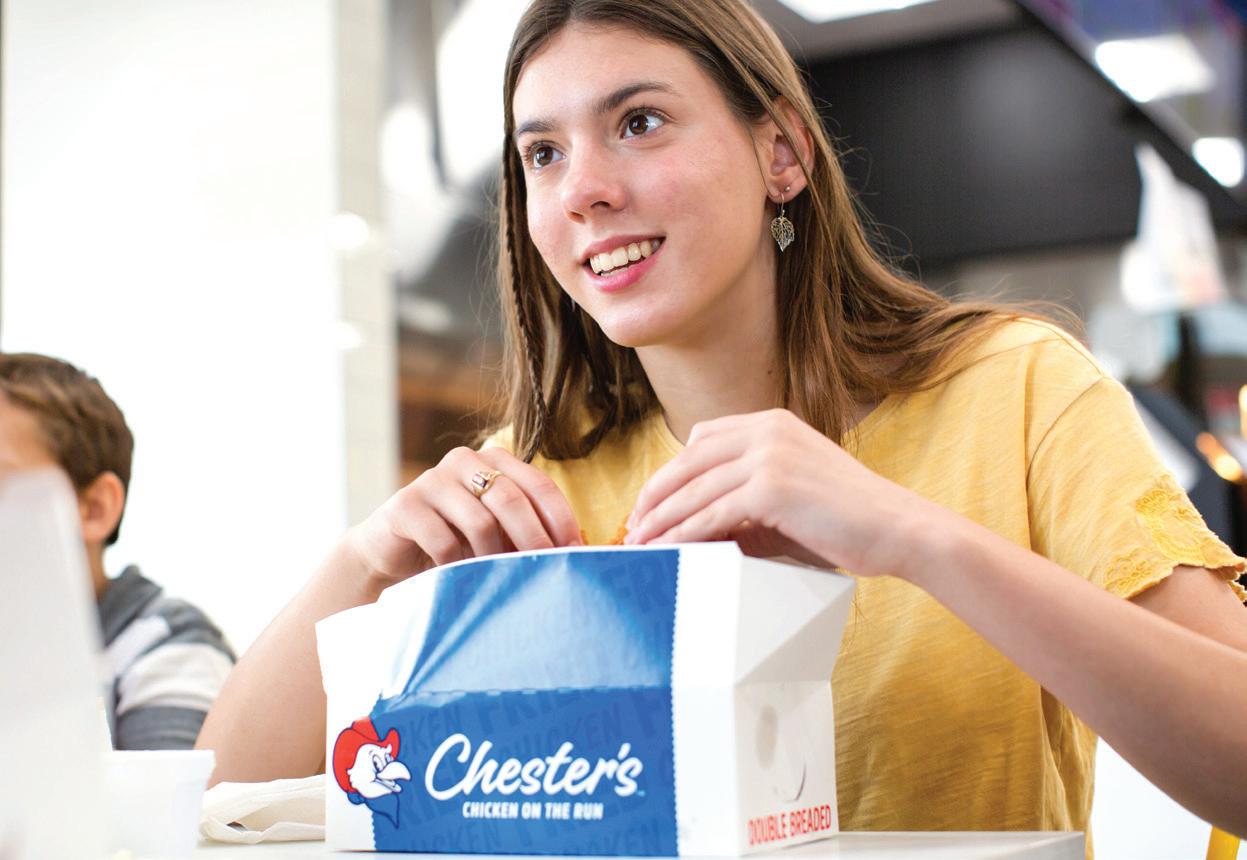
Our double-breading process always means better tasting fried chicken.

Chester’s loyal fans keep coming back for our delicious chicken, wedges, and more.

Wawa’s healthy food focus gives its customers more choices and helpful guidance
Longtime convenience foodservice leader Wawa Inc. recently rolled out its biggest investment yet in betterfor-you foodservice with the debut of the Good to Choose foodservice program and Balanced Choices Menu.



Based on the idea that individuals should be able to make their food and beverage choices with confidence, even as every day is different, Pennsylvania-based Wawa is focusing on three types of healthier choices: Balanced Choices, which feature reduced sugar, plantbased options and simple meals for those eating toward health and wellness goals; Clean Choices, which are free from artificial components like flavors, preservatives and colors; and Sustainable Choices, which are
sourced from supplier partners that share Wawa’s values on animal welfare and better farming practices.
Customers who want to focus on a particular choice can look for the respective menu icons to easily navigate their options. A wide variety of items are available across all dayparts. Those who want to plan ahead can visit Wawa’s website to browse meal ideas based on lower sodium, gluten conscious, high-protein/ low-carb, vegan and other diets.
Consumers who want to indulge can still enjoy their favorite treats at Wawa, but the retailer’s new better-for-you foodservice programs now make it easier to balance taste and nutrition.
mobile ordering, self-checkout stations, artificial intelligence (AI) technology to quickly identify store needs, customizable mobile apps and loyalty programs.
Although the COVID-19 pandemic served as a huge catalyst for these advances due to customers shying away from human interaction and high-touch areas, their usage has stayed high even as pandemic protocols have slowed or disappeared entirely.
“These are all extremely valuable tools to ultimately help our guests get in and out of the store as efficiently and comfortably as possible,
while taking some of the pressure off our employees as well,” Smartt said.
The role of technology in food at convenience store retailer Casey’s General Stores Inc. is also growing, said Art Sebastian, vice president of omnichannel marketing for the Ankeny, Iowabased chain of 2,500 stores in 16 states. Casey’s has been honing its handmade pizza program for more than 35 years.
The intersection of technology and food has been growing “over the last four to five years as we’ve assembled a new leadership team and started down this journey of becoming bigger, bolder,












































































more contemporary both on the guest-facing side, but also on the team-member side as of late,” he shared.
Sebastian anticipates technology becoming more and more integral to the category.
“On the consumer side, we know that the role of technology in lives in general continues to increase, right? The stats around how many U.S. adults have a mobile device, the stats around how many hours they spend on the mobile device, the blurring of apps. Now, you can transact through social media channels directly. You can one-tap order. There are so many ways to order. So, for consumers, there’s a significant amount of change
Kwik Trip’s new store design spotlights its proprietary o erings


Kwik Trip Inc., which has roots that go back to 1965, is ushering in a new generation.
The La Crosse, Wis.-based convenience store chain is building new stores that showcase its Generation 3 model. The updated store design incorporates softer colors and an open market feel. As soon as guests enter the store, a large open area invites them to browse all of the retailer’s proprietary food and beverage centers.
The Gen 3 model allocates more square footage to the retailer’s proprietary Hot Spot food program, which has continued to drive foot traffic since debuting 20 years ago. Kwik Trip also has invested heavily in its take-home meal program and its fried chicken program.

“Both have been a huge hit with today’s lifestyles. People on the go want choices they can grab that taste great and that the entire family can enjoy,” explained Steve Wrobel, the company’s public relations manager.
Plans this year call for a total of 40 new stores within Kwik Trip’s six-state footprint of Wisconsin, Minnesota, South Dakota, Iowa, Illinois and Michigan. All of the company’s new stores are being built according to the Gen 3 specifications and amenities.
“People love the open feel of our Generation 3 stores that invite people to browse and grab a coffee, a bakery treat, a hot slice of pizza or sandwich, chicken tenders, and many other food
in that space,” he explained.
A Chicago native, Sebastian has been pleasantly surprised by how quickly Casey’s guests have embraced technology. “I will bust the myth that
items at an affordable price. In today’s inflationary economy, people are looking for value,” Wrobel said.
“Retailers who are looking to develop a distinctive foodservice identity should always start with the consumer.”
— Kevin Smartt, Texas Born continued on page 50
We’ve got the ingredients you need to operate a turnkey branded pizza program with profi t margins 50% and higher.










Casey’s uses its customer data platform to drive foodservice sales



At Casey’s General Stores Inc., its customers are far from strangers.
The Ankeny, Iowa-based chain of 2,500 convenience stores in 16 states currently partners with Punchh as the loyalty engine for its industry-leading Casey’s Rewards program and the retailer works with Salesforce, a cloudbased provider of customer relationship management solutions, to maintain a unified platform for its customer data and profiles, which are approaching the 14-million mark vs. just 300,000 four years ago.
By optimizing this data set, Casey’s is able to know more about its customers, what they do in-store, what they do online and how they respond to messaging. The retailer can then send more relevant content and more personalized messages to customers, yielding higher open rates, higher clickthrough rates
and higher conversion rates. Ultimately, all of this leads to its Casey’s Rewards members visiting more often and spending more per transaction.
The Casey’s Rewards program recently surpassed 6 million members and more than 50 percent of those members are active on a 30-day basis, so it’s already a highly engaged group.
The chain, which has been honing its handmade pizza program for more than 35 years, utilizes its customer data platform to boost foodservice sales in various ways, according to Art Sebastian, vice president of omnichannel marketing for Casey’s. Once a guest is acquired through its marketing funnel, the journey begins and is ongoing.
“As we move them through the funnel, we’re going to engage them and retain them and then move them all the way to becoming a best guest, which is
our rewards member that subscribes to our marketing channels and interacts with us online, in the store and at the pump,” he said.
Ongoing engagement
can take the form of email, SMS app messages, social media, gamification, content on Casey’s fuel pump screens, digital menuboards in the stores and more.




Tamper Protection
Proven
Great for delivery!

Full Transparency
Exceptional clarity because shoppers like to see the food they buy.







Sustainability
You will be ready as the shift away from black carbon plastics continues.* *usplasticspact.org
We strongly recommend that customers test products under their specific conditions to determine fitness for use.
InlinePlastics.com/hot


rural America doesn’t use technology. They do. And that’s proven to us statistically in the fact that 6.3 million rewards members have downloaded our app and elected to engage with us digitally,” he said.
“And we’ve shared in past earnings calls more statistics around our growing digital business that’s coming from our rewards members ordering in the mobile app,” he continued. “So, we continue to see mobile app usage, both for ordering pizza but also participating in our rewards program — and that means saving offers, using unique onetime-use offer codes, playing the games that we built in our app experience, and so on.”

On the team-member side, like many c-store retailers these days, Casey’s is taking on the challenge of making its employees’ jobs easier and
more efficient. Sebastian likes to call it “the shift from clipboard and pen to technology-enabled ways of working.”
“For us, that’s going to continue to grow because we have to be efficient in order to keep up with the growing volumes our stores are seeing,” he said. “And as you know, this labor market is a challenging market and you’ve got to be a good place to work in order to keep your talent. A good place to work does not involve clipboards and pens; it involves what most team members are used to now: applications and technology.”
Looking ahead to the next 10 years, Weiner expects “a great ride for those out there that are working in foodservice.” The use of more highquality ingredients and more creativity in the product offering are on the horizon, he said, while the days of “fresh food” equating to a frozen packaged burger or breakfast sandwich being microwaved and placed in a heated grab-and-go display are “basically over.”
“Fresh prepared and assembled onsite is the future,” he predicted. “Made-to-order and/or some level of hot and cold grab-and-go is where this goes in the near future and for the long run, dinner plates of a complete meal will be part of this.
“I will bust the myth that rural America doesn’t use technology. They do.”
— Art Sebastian, Casey’s General Stores Inc.













Snacktime offerings will also encompass high-end foods and sides that can be a snack or an add-on to a meal.”



Smartt envisions a similar future. “Especially competing with QSRs, it’s critical c-stores are innovating in this space as customers are grabbing and taking meals home now more often than ever. We expect the future to also be filled with fresher options. No longer will guests have to decide between convenience and health or flavor,” he said.
The chief executive also foresees “added convenience” as a major focus for the next decade. “The future of c-stores is improving guest convenience options,” he stated. “This will mostly be through mobile ordering, mobile payment, third-party delivery and simple pickup options. For example, we’ve begun adding heated food lockers for easy, quick pickup.”
The nation’s transition to electric vehicles (EVs) and the rollout of EV charging stations are poised to have a major impact on convenience foodservice as well, making it even more important to prioritize fresh food as a means of drawing customers in.
As Smartt pointed out, it’s “not only providing EV charging stations, but finding ways to make EV guests comfortable. They charge their cars for at least 20 minutes as opposed to gasoline cars needing only a few minutes. How can we appease EV fuelers to choose our location to charge? Is that enticing them with healthy meal options and providing comfortable places to sit and eat while their car charges?”
Regarding the future of convenience foodservice, and particularly how the shift to electric vehicles will impact the business, Powell believes it’s all going to depend on how quickly convenience stores can make the transition. Parking garages are now mostly empty and aspiring entrepreneurs will see this as an opportunity to develop car charging destinations, he said.
“We will likely see less dependence on fuel as driving consumers in. If c-stores can be the go-to spot for EV charging, then coffee and bakery products will be popular,” Powell added.
Weiner speculated that while the transition to EVs is “the inevitable future,” it will likely take at least a generation for its effect on c-store foodservice to be measurable. However, the change will be felt gradually as the upward trend continues over the years, with EV charging becoming increasingly available at QSRs and fast-casual restaurants, plus drugstores, dollar stores and more.
“Their availability will make it imperative that c-stores have a destination offering other than gas to get customers on the real estate, and some form of inside seating that will also make the stop of EV charging and eating a viable alternative,” he said.














To stay on top of consumers’ foodservice wants and needs, technology will be essential.








Smartt sees the rise of AI in retail as another opportunity for convenience stores to evolve and improve. TXB is testing SparkCognition’s Visual AI Advisor solution at its Georgetown, Texas, store. This solution enables it to learn the store’s demographic mix of shoppers; where and when people traverse the store and spend time; service-level measures at the foodservice and checkout counters; and movement of customers from the forecourt to the store.
“This is extremely insightful for us as we’re able to identify when shelves are low on product faster, how many times someone has entered the restroom and how often we need to go in and clean, when there is a line at the register and more employees need to be at the counter to help checkout, etc.,” he said. “We’re excited to keep working with SparkCognition and their technology to further improve our customer service.”
Keeping the focus on the customer is a vital part of developing a foodservice identity that enables a c-store retailer to stand out instead of blending in with the competition.

“Retailers who are looking to develop a distinctive foodservice identity should always start with the consumer,” Smartt advised. “You will quickly identify community needs, preferences and ultimately gain their trust.”
Weiner suggests c-store operators study their competition and take note of what is working — and what isn’t. “I don’t mean to suggest that you should copy them. The last thing I believe in is a ‘me too’ approach,” he clarified. “However, looking at what they are doing that appears to be working will help in leading you down a path.”
Food that is new and different can yield very positive results.

“I am a great believer in unique but executable food,” Weiner said, recalling an instance where his company launched a fresh-off-thegrill cheesesteak in a region where no one else offered it. “Don’t be afraid to step out of the typical c-store box, but ensure you are keeping it highquality and fresh.” CSN


Roller grills rejoice! 56% of consumers are more likely to purchase items with name-brand ingredients,* which is why we offer a merchandising program that’s designed to bring more attention and appeal to the foodservice area of your store. Choose our delicious flavors and quality ingredients only America’s #1 Sausage Brand** can provide. For more information, please visit JohnsonvilleFoodservice.com
Family owned since 1945 • Proudly made in the USA
CONVENIENCE STORE operators and industry consultants alike agree that the foodservice category is a critical part of the channel’s future and investing in success means investing in prepared food and dispensed beverages. But that doesn’t mean that profit comes easily.
In 2022, c-store operators underwent a transition period as they made long-term plans for a postCOVID-19 world. Even as foodservice sales rose, retailers faced a perfect storm of challenges in the form of supply disruptions, major difficulties in hiring and retaining employees, and rising inflation.
The good news is that the storm appears to have passed — and while c-store operators still must navigate some choppy waters, it looks like sunnier days are on the horizon, according to the exclusive 2023 Convenience Store News Foodservice Study.
“Foodservice is seeing strong growth vs. other inside categories,” noted one study participant. “It’s a driver to foot traffic, and customers are trusting c-store food.”
Retailers’ belief in the long-term importance of foodservice can be observed in the growing space they’re devoting to it. While average store square footage has remained fairly consistent in recent years, the percentage allocated to foodservice increased 3 points since 2021.
Prepared food and hot dispensed beverages are
available at almost all of this year’s surveyed operators, with prepared food generating the bulk of revenue in the category. While availability of cold and frozen dispensed beverages has slipped slightly in recent years, likely due to a shift toward packaged drinks, they are still offered by a significant majority of c-stores.
Beyond just offering fresh food and beverages, c-store retailers are increasingly positioning themselves as foodservice destinations that are more than just convenient.
Consumers are go, go, going like never before. And, with on-the-go life comes the demand for better ways to on-the-go eat. Uncrustables® sandwiches are here to satisfy their demands with the familiar tastes they know and love—made easier to stock on shelves and easier to enjoy anytime, anywhere.





































The top foodservice amenities currently offered are microwave ovens for customer use (offered by 71 percent of respondents), in-store seating (48 percent) and outdoor seating (38 percent), all of which make it easier to enjoy a purchase onsite.
The top foodservice amenities retailers say they plan to add in 2023 are third-party delivery (26 percent), take-home/heat-and-eat dinner solutions (23 percent) and cook-at-home meal kits (13 percent), all of which enable customers to also enjoy a meal or snack on their own terms and indicate a shift toward more home consumption.
These investments in amenities are expected to pay off in rising sales and profits. Eighty-five percent of the retailers surveyed in this year’s study expect their foodservice sales to increase in 2023, bouncing back from the 70 percent who said the same last year. Just 2 percent believe their sales will decrease. Expectations for foodservice profits this year are more modest, but still more than three-quarters of retailers believe their profits will rise, compared to 57 percent a year ago.
When asked about their 2022 performance, 72 percent of retailers said their foodservice sales increased for






the year and 66 percent said their profits increased, jumping significantly from 66 percent and 46 percent in 2021, respectively.
Rising food and labor costs are the main factors in some respondents’ pessimism. Yet, others point out that c-store foodservice benefits from offering greater value to customers, and the ease of purchasing through drive-thrus or self-order kiosks attracts those who want a quick bite.
While the average expected increases for sales (11 percent) and profits (8 percent) in 2023 are more modest than in recent years — with operational challenges tempering expectations — retailers’ overall positivity makes one thing clear: Savvy c-store operators are all-in on foodservice.
“Our No. 1 focus is our foodservice,” one retailer remarked. “We held true to our commitment
of using only the best products and didn’t cut costs by cutting portions. Of course, our prices went up, but our sizes and good quality product never changed.”
Breakfast sandwiches remain the top prepared food item offered at c-stores, available at nine out of 10 retailers. Pizza is experiencing a strong surge as it rises to No. 2, offered by 85 percent of respondents — up from 68 percent in 2021 and 74 percent in 2022. Several other items are showing double-digit growth in availability compared to last year. These include soup (up 28 percent), salad (up 17 percent) and hamburgers (up 16 percent).
Prepared food is nearly split evenly between being assembled in-store (69 percent of respondents) or delivered ready to heat and serve (67 percent). C-store operators are shifting away from food prepared at commissaries in favor of convenience and foodservice distributors.
Hot beverages and fountain drinks lead retailers’ dispensed























beverage offerings. Hot coffee has fully returned to its position as a c-store staple, posting significant gains in availability compared to two years ago. Hot chocolate is also available at eight in 10 retailers.
Iced coffee and hot chocolate experienced the greatest growth in availability over the past year, while smoothies, frozen drinks and hot cappuccino/latte/espresso saw the greatest decline in availability among c-stores, according to the study’s findings.
The most common types of foodservice equipment used by convenience store operators are the necessary basics — microwave ovens for food preparation and both warmand cold-temperature food display cases — but operators are showing a willingness to invest in equipment that will make better food faster. Speed-cook ovens and convection ovens experienced the greatest growth in usage year over year, up 16 percent and 14 percent, respectively.
The top types of dispensed beverage equipment used by retailers are traditional fountain drink dispensers, coffee makers and self-serve cappuccino/latte/hot chocolate makers.
Just over a quarter of respondents report franchising or licensing branded foodservice concepts, keeping relatively consistent with previous years.
Lunch and breakfast are the leading dayparts for convenience foodservice and generate the majority of category sales. Lunch’s share of sales grew 3 points over the past year and now represents more than a third of total daily foodservice sales.
Interestingly, retailers pointed to breakfast as the daypart that experienced the biggest sales decline in 2022. This year, however, the largest percentage of retailers (28 percent) point to breakfast as the daypart they predict will experience the biggest sales growth in 2023.
C-store operators are also bullish on the dinner daypart this year, with a quarter of respondents predicting it will have the biggest sales growth in 2023. Dinnertime sales currently account for 15 percent of total daily foodservice sales, trailing behind lunch and breakfast.
Late night has now taken the crown as the daypart most likely to experience the biggest sales decline this year, followed by the morning snack and evening snack dayparts.
In terms of challenges facing the category, 98 percent of retailers reported that their foodservice costs rose in 2022 compared to the previous year. It’s not surprising then that 97 percent of respondents also reported increasing their prices. Two-thirds of retailers said they raised prices across the board, while 31 percent only raised prices on some items.
The biggest obstacle to foodservice success right now, though, is difficulty in hiring and retaining employees: 80 percent of retailers cite this as their biggest obstacle, up 5 points year over year. Meanwhile, the percentage of retailers citing the supply chain as their biggest obstacle fell to 56 percent this year from 84 percent one year ago.
While the supply chain is still the No. 2 obstacle, other challenges on the rise are operational inefficiencies at the store level and increasing competition for the foodservice business.
Dealing with lingering supply chain challenges, 72 percent of retailers said they removed at least one food item due to supply chain issues last year, and just 21 percent of those who removed items believe all items will eventually be brought back.
On a positive note, supply chain issues are expected to continue easing this year, as 64 percent of respondents predict the supply chain will improve in 2023, up 30 points from a year ago. CSN




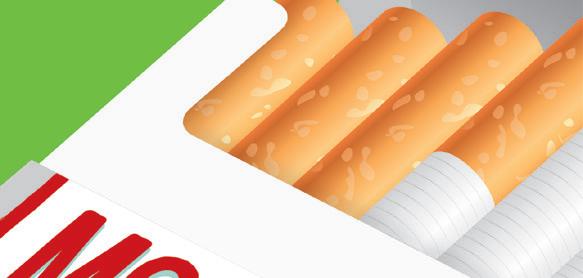






































 By Renée M. Covino
By Renée M. Covino
BEFUDDLED BY SOME or all of the regulatory balls in play for tobacco this year? You’re not alone. There’s much confusion among convenience store retailers regarding Food and Drug Administration (FDA) rulemaking, including what the process is, if and when regulations will take effect, what constitutes an unlawful product, if enforcement can take place against retailers selling unlawful products, and more.
To maintain a handle on what’s happening at the federal level of tobacco regulation and litigation, Convenience Store News has compiled the following playbook outlining the top issues, complete with the latest updates and bottom-line conclusions.
THE ISSUE: In late April of last year, the FDA published two new proposed regulations, referred to as product standards. A product standard is the power Congress gave to the FDA to reduce or eliminate an ingredient in a tobacco product or a constituent in tobacco smoke.
“This is a very significant power because it can result in products being removed from the market,” explained Thomas Briant, executive director and legal counsel for the National Association of Tobacco Outlets (NATO).
Such is the potential here. The first proposed regulation would prevent menthol as a flavor in cigarettes, rollyour-own (RYO) cigarette tobacco and heated tobacco products. The second regulation would prohibit all flavors in cigars.
THE LATEST: The FDA has received more than 175,000 public comments (including from retailers) on the menthol ban, and almost 72,000 public comments on the cigar ban — most in opposition. The FDA must read every single comment and issue a report on the comments before any regulation is finalized, according to Briant.
In early January of this year, the agency issued a statement that it expects both the menthol cigarette and flavored cigar ban regulations to be finalized this August. “That does not mean the regulation will go into effect in August,” Briant emphasized. “And, before the regulation can be finalized, the FDA needs to send the final regulation to the White House Office of Management and Budget (OMB) to conduct its own review of the regulation because this regulation would be economically significant to the country.”

Beyond that, the FDA asked for public feedback when it first proposed the regulation on extending the effective date to two years, rather than the usual one-year period. Some manufacturers asked in their comments that the FDA make the effective date six years after the regulations are finalized. “Then, there’s also the possibility that lawsuits will be brought against the regulation if it is finalized by the FDA, which may further delay an effective date,” Briant pointed out.
THE BOTTOM LINE: Even if this regulation is finalized this August, it will not take effect for at least one year, two years, or possibly even more years down the road.
THE ISSUE: The FDA has a comprehensive plan for products that contain nicotine, whether derived from tobacco or not (synthetic nicotine). Essentially, this plan involves lowering nicotine to what the agency believes is a minimally addictive or nonaddictive level. The goals of this plan are to reduce the likelihood of future generations becoming addicted to nicotine and make it easier for current smokers to quit tobacco products.
Last June, the FDA stated that it plans to pursue a regulation that would set a maximum level of nicotine in cigarettes and possibly other combustible tobacco products but, at this time, it has not said what that maximum level would be. Currently, cigarettes range from nicotine levels of approximately 7.5 milligrams up to approximately 13.5 milligrams.
“As a part of this potential regulation, the FDA must determine that any product with very low nicotine is appropriate for the protection of the public health,” Briant noted.
THE LATEST: This January, the FDA indicated it would propose this regulation by October of this year. Once it is proposed, as with any regulation, the public would be given time to submit comments. Then, the agency would be required to read all the comments and issue a report responding to them, before finalizing any such regulation.
BOTTOM LINE: This regulation is still in the early stages. It is expected to be formally proposed in October, with no indication yet as to the nicotine-level parameters.
THE ISSUE: Federal law and FDA regula-
tions require that tobacco products introduced after Feb. 15, 2007, have a premarket tobacco product application (PMTA) submitted to the FDA for review, and that the agency must submit a marketing granted order (MGO) authorizing the product for sale in the U.S. market.
The filing deadlines have passed: tobacco-derived product PMTAs were due by Sept. 9, 2020, while synthetic nicotine product PMTAs were due by May 14, 2022. To receive authorization, the agency must determine that the marketing of the product is “appropriate for the protection of the public health.”
There are four steps a PMTA must go through at the FDA:
1. The agency must accept or refuse to accept the PMTA.
2. If it accepts the PMTA, the agency files or refuses to file the PMTA application.
3. If it files the PMTA, the FDA must “substantively review” the application and all accompanying documents.

4. After this review, the FDA issues either an MGO authorizing the sale of the product, or a marketing denial order (MDO) requiring the product to be removed from the market.
The agency received applications for more than 8 million tobaccoderived products, the vast majority of which were electronic cigarette or nicotine vapor products. Of the roughly 8.9 million e-cigarette products in the PMTA process, more than 8.6 million have been denied to date due to either a refusal to accept, a refusal to file or a marketing denial.
This leaves 348,599 products pending; that is, their PMTA applications are still under review. There’s also a much smaller number of applications that remain for cigars, hookah tobacco, pipe tobacco, RYO products and smokeless products.
“As of this March, the FDA has authorized only 45 MGOs for tobacco and vapor products. Only tobacco flavor has been allowed in any of those,” Briant said.
Given that of the roughly 10 million tobacco-derived and synthetic nicotine products with submitted PMTAs, only 45 are allowed so far on the U.S. market, the NATO director added that “as a percentage, that’s 0.0000045 percent.”
THE LATEST: Recently, the FDA issued two MDOs for Logic menthol e-cigarettes. However, Logic filed for and obtained an emergency stay. Further court proceedings are pending.
Also, in the past two months, the FDA issued MDOs for four Vuse menthol refills for e-cigarette devices. The manufacturer, R.J. Reynolds Vapor Co., subsequently filed an emergency temporary injunction, which the court granted. Those proceedings are still pending, too.
PMTAs remain under review for additional e-cigarette and vapor products made by Juul, Vuse, NJOY, Logic, blu, Smok and Puff Bar. “Pursuant to a court order, the FDA filed a report that it expects to complete the review of pending PMTAs by Dec. 31, 2023, for those electronic cigarette and vapor products that have a 2 percent or greater market share,” Briant explained.
Regarding synthetic nicotine products, the agency received PMTAs for almost 1 million products. To date, it’s issued refuse-to-accept letters for more than 925,000 of them. The FDA accepted 8,600 of the applications, most of them e-cigarettes, for which the review
process is ongoing. “It’s important to note that so far, no MGOs have been granted for synthetic nicotine products,” said Briant.
BOTTOM LINE: The FDA has approved only 45 tobacco and vapor products to be marketed in the U.S. thus far; only tobacco flavor has been allowed in any of these. No synthetic nicotine products have been granted market approval yet. Court proceedings are pending for some popular brands that were previously denied market approval. The FDA expects to complete the review of pending PMTAs by Dec. 31, 2023, for those electronic cigarette and vapor products that have greater than a 2 percent market share.
THE ISSUE: Lawful tobacco products include products on the market on or before Feb. 15, 2007; those products determined to be substantially equivalent or have a substantially equivalent exemption; and PMTA products for which the FDA issued an MGO.
The latter category includes eight Swedish Match General products, two 22nd Century Group VLN cigarettes, eight Marlboro Heatstick products, four U.S. Smokeless Tobacco Co. Verve products, nine R.J. Reynolds Vapor Co. Vuse products, eight Logic products and six NJOY products.
Unlawful tobacco products are a much larger pool. According to Briant, they include all new products after Feb. 15, 2007, without an MGO or a substantially equivalent exemption; products with no PMTA submitted; products with a PMTA submitted that were denied application, filing or marketing; and all products with pending PMTAs under review by the FDA (this includes e-cigarettes, cigars, pipes, RYO, smokeless tobacco and synthetics).
“Now, some of you may be thinking, ‘But some of these products are still on the market.’ Legally, they are not supposed to be,” Briant maintained “All products with a PMTA pending are unlawful to market.”
The FDA released a statement on unlawful products: “All new tobacco products, including all e-cigarettes, on the market without the statutorily required premarket authorization are marketed illegally and are subject to FDA enforcement action.”
According to Briant, this means the FDA can take enforcement action, issue fines and seek criminal and civil penalties against the manufacturers, as well as the wholesalers and retailers that are selling unlawful tobacco products.
THE LATEST: The FDA is beginning a new level of enforcement, especially against manufacturers. Why now and not sooner? “Because the agency has been quite rightly overwhelmed by the sheer number of PMTAs that require agency authorization to be marketed and they have limited resources and limited personnel,” said Briant.
Now, though, the FDA is able to start prioritizing its enforcement efforts on products with no PMTAs submitted, products with a marketing denial order, flavored cartridge e-cigarettes that are not tobacco or menthol flavor, e-cigarette manufacturers not preventing youth access, and e-cigarettes that are targeted to youth, Briant outlined.
BOTTOM LINE: There are substantially more illegal than legal tobacco products currently on the market. The FDA is beginning a new level of enforcement that is primarily against manufacturers; however, retailers and wholesalers are also subject to penalties. CSN
To date, the FDA has given a marketing granted order (MGO) to only 45 tobacco and vapor products, authorizing these products for sale in the U.S. market.
THE CHECKOUT PROCESS at convenience stores has changed rapidly in recent years, driven by rising labor costs and new technologies. Retailers are experimenting with or in various stages of deploying some sort of autonomous checkout solution, whether it be in the form of self-checkout kiosks, mobile checkout or frictionless checkout that uses computer vision and machine learning.
With autonomous checkout on the rise, the impulsivity of the candy category is in jeopardy. Leveraging an autonomous solution may improve the shopping experience by cutting down or removing wait times, but it also impacts front-end purchases such as candy. As a result, retailers have a more limited window of opportunity now to engage customers in one final attempt to build their basket with impulse, high-margin categories like confectionery.
Approximately 15.4 percent of c-store confectionery sales come from items purchased on impulse during the checkout process, according to the latest data from VideoMining’s C-Store Shopper Insights (CSI) Tracker program. If there isn’t a dedicated checkout area within the store, retailers risk losing these impulse candy sales purchased at the front end.
“Our current data shows that impulse confectionery sales are happening much less frequently (60 percent less) compared to the traditional staffed checkouts. Part of the reason may be that as retailers roll out self-checkout kiosks, front-end merchandising has not evolved to match the checkout process,” Rajeev Sharma, founder and CEO of State College, Pa.-based VideoMining, told Convenience Store News. “Shoppers also spend less time waiting for self-checkout kiosks to be open [when] compared to waiting for cashiers in the traditional checkout process.”
Today’s shoppers are increasingly looking for speed and convenience, and are more open to leveraging new technologies, especially at checkout.
While still small overall, self-checkout usage is gaining acceptance where it is available. A 2020 consumer survey conducted by Researchscape on behalf of Zynstra, an NCR company, found 15 percent of shoppers will leave a convenience store and abandon their purchase after just one minute of waiting in line, with nearly half of these shoppers leaving after only 30 seconds. Of those surveyed, 61 percent said the presence of an available self-checkout option would change their decision to abandon a purchase due to a long checkout line.
“As autonomous and self-checkout adoption rises, and shopper dwell time in a physical transaction zone is limited, highly profitable impulse items like candy, gum and mints may be less visible to shoppers,” noted Jim Dodge, vice president, convenience at Mars Wrigley.




















































































































Citing c-store foundational research, Dodge pointed out that 35 percent of self-checkout registers do not have confectionery available currently. And where there is confectionery merchandised at self-checkout, it performs 20 percent below the manned checkout. “Studies show the lack of availability and visibility leads to fewer impulse purchases,” he said.
Army & Air Force Exchange Service
Buyer III Heather Key told CSNews that the chain’s chocolate grab-and-go items have decreased in units partly due to the recent implementation of self-checkout. However, as the nonchocolate category continues to be an industry growth driver, the Exchange is putting a larger selection of these items at self-checkout and seeing unit increases, she said.
“Due to little-to-no dwell time, it is important to have the right fixtures and assortment near self-checkout terminals for last-minute purchases,” Key emphasized. “The Exchange pays close attention to confection and snacking trends, employs space-to-sales analytics and works to ensure the inventory reflects customer wants.”
As the checkout process evolves in c-stores, the behaviors of shoppers change with it. Given this new retail environment, VideoMining’s Sharma advises retailers to evolve their merchandising strategies in tandem with the kind of autonomous checkout they offer and not treat it as an afterthought.
“The overall strategy is to make confectionery visible to shoppers waiting for checkout, but tweaking it to account for the physical space and different checkout types being [offered],” he said. “The best strategy is to group stores based on the prevailing front-end dynamics and physical space available to develop the ideal merchandising playbook. The fundamental best practice is allocating the most visible area to products such confectionery that have high impulse potential.”
Sharma also offers these strategies to drive impulse candy sales in the new environment:
• Mission-based merchandising: By segmenting shoppers’ trips into missions, c-store retailers can adapt both their core merchandising and secondary displays to
Approximately 15.4% of convenience store confectionery sales come from items purchased on impulse during the checkout process.
Source: VideoMining C-Store Shopper Insights (CSI) Tracker
help guide and “delight” customers with specific tactics for incremental sales. “For example, candy can be part of a lunch mission, so special displays in the ‘meal building’ areas with exciting messages can address that need and lead to incremental sales.”
• Secondary displays: Endcaps and freestanding displays can drive impulse for candy as shoppers navigate the store. “Such displays currently drive about 26 percent of all candy sales in the channel and could be further expanded in lieu of the traditional front-end merchandising to make up for some of the lost impulse.”
If a c-store still offers manned checkout as well, a queue system in the transaction zone can engage shoppers while they wait and compel one last purchase. In fact, 60 percent of shoppers don’t mind waiting in well-merchandised queue systems, according to Dodge of Mars Wrigley.
“Ninety percent of shoppers think it’s easier to navigate, one in four confectionery shoppers will make a purchase, and shoppers extend their ‘shopping mode’ for roughly 45 seconds,” he said. CSN
















Today’s consumers are willing to indulge in foods that spark joy and enhance their wellbeing
By Danielle RomanoAFTER CONTENDING WITH an unprecedented and tumultuous two years of the coronavirus and then shifting into a post-pandemic world, coupled with the economic pressures brought on by inflation, today’s consumers want to live life on their own terms — especially when it comes to choosing why and how they snack.
Americans have increasingly turned to snacking to fulfill different needs in their lives, whether it’s meal replacement, a sense of comfort or rewarding themselves. Taste, health and value are evergreen food needs, but these attributes are reflected differently today when it comes to snack choices and how certain food or snack choices impact consumers’ wellbeing.
“Consumers seem to be bringing emotion into eating like we have never seen before,” Dan Meyer, consumer insight manager for convenience stores at General Mills, told Convenience Store News. “As consumers have gone through a health pandemic, they are more willing to indulge in foods that bring them joy. They are willing to forgive themselves and offset their indulgence somewhere else,
e.g., skipping a meal or eating healthier at a different time of day.”
As for what’s currently trending, Meyer cites recent data that shows both the sweet snack and salty snack categories are growing, while better-for-you is on the decline. He relayed that there is less avoidance right now among consumers, who are curbing restrictions around what they perceive as “bad” for them, like sugar and carbs, and “unashamedly snacking on what they want” and “living for today.”
By living life on their own terms, consumers are absorbing rising costs when it comes to enjoying their favorite snacks. But because they’re probably cutting back in other areas, snacking is one indulgence that can be a quick, easy and affordable part of consumers’ days.

“When you’re hungry and want something quick, easy and delicious, you grab a treat. You might be making sacrifices on the weekend when you’re doing your major food shopping, but by Wednesday, when you’re out and about and you want a quick snack, you’re not willing to sacrifice that,” said Liz Williams, CEO of Chicagobased Foxtrot, a retailer that marries the best of neighborhood retail and e-commerce technology to create a community of discovery.
During 2020 and into 2021, as living and working from


home became more continuous, consumers partaking in three-plus snacks per day increased 3 percentage points to 45 percent of consumers, Circana’s "2023 Snacking Survey" found.
Moving through 2021 to today, schoolaged kids have gone back to in-person learning five days a week, and many adults have returned to an in-person workforce. However, hybrid working continues for 60 million people and could be anywhere from one to five days per week.
“When this occurred, everyone thought that snacking would revert back to pre-COVID levels. However, we have seen an uptick in snacking consumption. Forty-nine percent say they are snacking three-plus snacks per day, which is up 4 percentage points in two years,” noted Sally Lyons Wyatt, executive vice president and practice leader, client insights for Chicago-based Circana, formerly IRI and The NPD Group.
“Snacking is a lifestyle in the U.S. COVID didn’t impede this fact, it accelerated it. Consumers are prioritizing snacking because it is how they eat and drink across the day, from early morning to late night,” she explained.
Foxtrot’s Williams refers to this circular lifestyle as “clockless eating.”
“The snacking category continues to grow and COVID-19 didn’t alter that in the sense that snacks have grown preCOVID, during COVID and post-COVID,” she said. “Snacking is an occasion over the years that has grown into ‘clockless eating,’ whereby we’re not eating squared meals and snacking permeates throughout the day.”
With the onset of the coronavirus pandemic, the biggest shift in snacking occurred around the draw of at-home consumption vs. on the go. But, as more consumers are out of the house postCOVID, this is influencing the way snacks are consumed.
“It used to be ease and convenience were the important factors — getting in and getting out or, during COVID, getting delivery was the key part of the experience. Now, speed and convenience are still important, but service and experience are also part of snacking more so,” Williams pointed out. “Grabbing a snack
in a place that has a good atmosphere, is welcoming, is clean and has good customer service is important as more consumers are out and about in the world.”
One purchasing trend that was exasperated by the pandemic is consumers buying snacks online and getting them delivered to their doorstep at the click of a button. Consumers have more options online, such as pack sizes and perceived value, giving them the opportunity to choose larger count sizes to dole out their snack portions over time vs. the single-serve sizing that is most prevalent at convenience stores.
“This will likely shift again once consumers are more on the go,” General Mills’ Meyer predicts.

Still, as consumers continue to bring emotion into eating — particularly when snacking — c-stores are well positioned to offer options that spark joy or will surprise and delight them.
“It’s like an individual treasure hunt where consumers can find snacks ‘just for me’ that they can’t get anywhere else,” Meyer said.
So much of today’s shopping experience is hyper-personalized with mobile apps and online experiences that cue up offers and products to consumers that are “just for them.” Consumer communication and partnerships with in-store apps and digital play into this and can help retailers capture that next purchase by the shopper, he added.
Meyer advises c-store operators to have attractive offers in place to drive traffic, including signage, co-promotions and reformatted packaging to make products stand out on the shelf.
“Retailers can work with manufacturer partners, like General Mills, to promote snack brands on-shelf. For instance, we regularly work with retailers on temporary price reductions and item bundling to help promote and drive trial on new items or flavors within existing product lines,” he said.
Circana’s Lyons Wyatt encourages c-store retailers to also leverage social media. These platforms provide opportunities to engage, delight and surprise current and future convenience store shoppers.
“Get creative — find influencers and/or create content that will influence. Message the many different snack occasions that convenience can provide the snacks of their choice,” she said. “Once [consumers] are in the store, find ways to interrupt via promotions, signage and/or displays.” CSN
“As consumers have gone through a health pandemic, they are more willing to indulge in foods that bring them joy. They are willing to forgive themselves and offset their indulgence somewhere else.”
— Dan Meyer, General Mills

































































































































RIGHT NOW, convenience store retailers have access to more information than ever before — yet not as much as they will have tomorrow and the next day. With all that data at their fingertips, it is crucial to know how to use it effectively.
For several years now, data mining has largely meant digging deep into the numbers and uncovering insights to build a loyal customer base, engage with them when, where and how they want, and get a leg up on the competition. However, by focusing solely on customer data and overlooking the information coming from the total store — and the forecourt — c-store retailers risk missing the opportunity to enhance the overall shopping experience.

“Customer data gets a lot of coverage because of the outsized influence of marketing in the era of Internet and social media. Tech giants like Google and Facebook provide extremely accurate profiles for companies to target via ads. Several techniques have been developed to optimize ad campaigns and measure efficiency via A/B testing,” said Suresh Menon, senior vice president and general manager, software and solutions, for Lincolnshire, Ill.-based Zebra Technologies Corp. “Lost in this marketing focus is the importance of analyzing data for the rest of the business, especially inventory and supply chain.”
Zebra Technologies offers solutions to elevate the shopping experience, track and manage inventory, as well as improve supply chain efficiency. In 2020, Zebra acquired Reflexis Systems Inc., a provider of intelligent workforce management, execution and communication solutions for organizations across numerous industries, including retail and foodservice.
With smaller selections and high turns, c-store retailers must ensure on-shelf availability of key products, according to Menon. “Stock outages lead to lost sales and poor customer experience. A focus on marketing without attention to inventory could lead to a truly negative outcome where physical or digital traffic is directed to products that are out of stock,” he said.
Part of utilizing data effectively, though, is knowing what to do with it.
“A lot of retailers are sitting on large troves of data and often do not use it to maximize value. A digital journey takes focus and commitment,” Menon pointed out.
Data can give retailers visibility into their stores — something most convenience store operators are looking for, noted Jennifer Williams, vice president of AccuStore, a GSP company, headquartered in Clearwater, Fla. AccuStore helps retailers collect data from within each store to build a store profile, something that can especially benefit large chains spread across geographies.
“We find a lot of retailers struggle with having clear visibility into their locations, particularly with a higher number of locations, and also because of the high penetration of acquisitions within the convenience store industry,” Williams said. “You have these acquisitions that take place and you try to brand and standardize those acquired sites to your customer, but you don’t know what those locations look like.”
Looking at the data can help retailers standardize, and market and message to their customers in a clean and consistent way. “It’s about understanding what’s in those stores and helping them maintain accurate data. In any retail industry, but in particular in the convenience store industry, those stores are ever-changing on a day-to-day basis,” she added.
Sophisticated retailers capture historical sales and inventory numbers at a granular level, feed it into advanced artificial intelligence/machine learning models, and are then able to forecast demand with a high level of accuracy. In turn, the forecast can be used to drive a series of decisions around inventory allocation, replenishment, reordering and pricing.
“The combination of systematic data capture and advanced analytics can significantly improve the operating margin of a retailer,” Menon pointed out.
He cautioned, however, that a retailer trying to undergo a digital transformation should understand that success is more than just data and algorithms. It is also about people and organization.
“Change management is often overlooked,” he said. “There are many examples of retailers implementing analytical systems, only to find their team going back to their legacy spreadsheets. The last mile of adoption of data-driven analytics is just as tricky as getting the costs of last mile delivery under control.”
Knowledge is power, but that knowledge can get lost in translation, so to speak, if different aspects of an organization are working with different — or inaccurate — information, Williams warned. When multiple divisions all work siloed and with their own set of data, you lose data integrity and human error occurs when shared back and forth, she said.
“Legacy systems [and] outdated processes make it hard to get your arms around all the data and utilize it. One centralized repository for all to access store data can function as the ‘single source of truth’ that operations, marketing and store managers can all rely upon,” she explained.
And data capture and analytics shouldn’t be limited to within the four walls of the store. There is so much that happens on the exterior, including outdoor seating, car washes and the forecourt.
“Having the insight and knowledge to
what is happening on the perimeter of the outside of the store — as well as back of house for facility purposes — it is definitely an overall arching theme by request to have that insight of the total property,” said Jamie Banks, marketing manager for AccuStore.
Boise, Idaho-based Stinker Stores, operator of 110 convenience stores, recently tapped AccuStore to implement a retail intelligence platform. The move is aimed at giving Stinker Stores detailed store profile data to drive strong executions.
AccuStore’s parent company, GSP, also works with convenience retailers as a marketing partner, including Fort Worth, Texas-based Yesway and Powell, Tenn.-based Weigel’s.
Unlike grocery or big-box stores, convenience stores sometimes have to sacrifice space to maintain convenience, but an important part of being convenient is having the products customers need and want on the shelves, and letting them know it.
As Zebra Technologies’ Menon noted, out-of-stocks lead to lost sales, which hurt the topline; however, with space constraints, c-stores cannot carry too much “safety stock.”
“Advanced analytics can help in precisely these situations by creating an accurate forecast and recommending an optimal reorder quantity,” he said. “This balances the inventory to maintain high service levels without overstocking, which leads to potential discounts.”
Additionally, advances like shelf edge cameras can track shelf availability in real time and trigger alerts to get the replenishment process going. Adopting these technologies could provide a significant competitive advantage, he stated.
The competitive nature of the current retail landscape is driving the need to acquire new customers and retain those customers, having them come back multiple times and become loyal to the brand, according to AccuStore’s Banks.
“Having that insight from the data allows you to take appropriate action and, hopefully, take it to the next level and outperform the competition,” she said. CSN

CONSUMERS TODAY are becoming more motivated by social issues, and they are more likely to buy when companies and brands support the social issues that are important to them, according to research from EthniFacts, a cross-cultural knowledge and insights provider.

While this sentiment had decreased during the COVID-19 pandemic, it is now on the rise again. EthniFacts’ Fall 2022 PICAT (Personality and Intercultural Affinity) study found that all age groups are more likely to buy from companies that support social issues important to them. Generation Z, aged 16-24, is the most likely to buy based on social issues.
PICAT is a semiannual national survey of American consumers that measures attitudes and behaviors through a cultural lens and gauges their impact on consumption. PICAT aims to understand crosscultural attitudes and behaviors, reveal insights about consumer behaviors, and find common ground among diverse communities in today’s dissonant marketplace.
There is one issue that appears to unite all age groups and all races and ethnicities: the fair treatment of employees.
is the most likely
Support for social issues varies by generation:
• Gen Z prioritizes the issues of racial/ethnic equality, BLM (Black Lives Matter), LGBTQIA+ and women’s equality.
• Millennials, aged 25-39, prioritize the issues of racial/ethnic equality, protecting the environment, unifying Americans and women’s equality.
• Generation X, aged 40-59, prioritizes the issues of protecting the environment, unifying Americans, supporting veterans and supporting small businesses.
• Boomers, aged 60-plus, prioritize the issues of
supporting America, supporting veterans and supporting Christian values.
Race and ethnicity also influence support for social issues. For instance, Hispanics are most concerned with companies paying their employees a living wage, while non-Hispanic Blacks are most concerned with racial/ethnic equality, and non-Hispanic Asians are most concerned with protecting the environment, according to the latest PICAT study.
There is one issue, though, that appears to unite all age groups and all races and ethnicities: the fair treatment of employees. Companies paying their employees a living wage motivates Americans to buy more than any other social issue. CSN
The Business Case for Diversity & Inclusion program is part of The Convenience Inclusion Initiative, a Convenience Store News platform that champions a modern-day convenience store industry where current and emerging leaders foster an inclusive work culture that celebrates differences, allows team members to bring their whole selves to work, and enables companies to benefit from diversity of thought and background.
The next iteration of Fuel City’s convenience stores advances the company’s “Where Dreams Come True” slogan
By Danielle RomanoFuel City
Opened: December 2022
Location: 1800 N State
Hwy 78, Wylie, Texas
Size: 10,000 square feet
Unique features:
A new open, airy store design that features retro pops of color and playful graphics; Fuel City’s flagship street taco and daquiri programs; a new growler bar concept; 29 fueling positions; 24-hour drive-thru for food and beverages; 6,000-square-foot car wash
FUEL CITY IS ON A MISSION. Since 1995, the family-owned and -operated chain of eight convenience stores throughout Texas has aimed to create a fun place in which to have positive experiences with expansive offerings and services. Its slogan, “Where Dreams Come True,” is a sort of whimsical embodiment of how the company hopes its business impacts people.
The company’s newest store, which debuted in December, is the next iteration of Fuel City and ushers in a new concept that incorporates a more transitional take on the exterior architecture and interior, while maintaining the retailer’s “Texas urban ranch” aesthetic.
To create a sense of hospitality and a welcoming environment, the new open, airy store design contrasts industrial exposed ceilings with residential finishes like wide-plank white shiplap. Throughout the signage and interior finishes, the design features retro pops of color and graphics to add the playful touches guests expect to find at a Fuel City store.
“This store is a convenient, clean and fun place to stop in for a quick visit, or stay for a while and enjoy a meal with the family in either the indoor or outdoor dining rooms. Our indoor/outdoor patios have music and TVs, so you can cheer on your
favorite sports team or catch the news any time of year,” Fuel City CEO Joseph Bickham told Convenience Store News

When it came to determining where to test this new Fuel City concept, the company landed on the city of Wylie, Texas, for a few reasons. First off, the city has been in “hyper growth mode” over the last decade driven by its strong school system and safe, friendly community. The timing was right to capture an expanding market that was underserved, Bickham pointed out.
Secondly, because Highway 78 acts as a commuter road for growing cities to the east, this area provides a great combination of rooftop density for the local base, travelers for growth, and ease of access for destination visits.
Lastly, the city was equally as excited for Fuel City to become a part of the neighborhood as the c-store retailer was to plant roots there. Wylie viewed Fuel City as a good partner to attract people to the city, according to the chief executive.
“Wylie has been great to work with. Not every city embraces you, your concept and your vision. [Wylie] did early on and I give the city credit for being open to and appreciating our concept, and working

















with us to facilitate getting built and getting open,” Bickham said.
Once Fuel City identified the right property in Wylie to build on, the project was completed in about 12 months and opened to the public on Dec. 30, 2022. Clocking in at 10,000 square feet, the c-store is located at 1800 N State Hwy 78 and situated on an 8-acre site.
Like other Fuel City locations, the Wylie store features the company’s flagship, award-winning street taco program, which is offered 24 hours a day, seven days a week. Spanning all dayparts, the Fuel City Tacos menu boasts such varieties as the picadillo taco, the beef fajita taco, the chicken fajita taco, the barbacoa taco and the pastor taco. Customers can order burritos, bowls and quesadillas, too.
The store also showcases Fuel City’s daquiri program, as well as a new growler bar concept displaying 20 local draft beer taps for either on-premise consumption or to take to go in a custom Fuel City branded growler or crowler can.
Other offerings available to satisfy cravings at any time of the day are:
• A Little Caesars pizza restaurant serving freshly made hot pizzas ready to go;
• Doughnuts made in-house daily and locally baked desserts;
• Hand-cut seasonal fruit; and
• Sandwiches and other handprepared convenience foods.
When it comes to amenities, there is indoor/outdoor seating, a total of 29 fueling positions, and a 24-hour drive-thru for food and beverages. An accompanying 6,000-square-foot car wash is expected to open in May.

And, as always, Fuel City enjoys partnering with local food and product suppliers to support the community and offer unique products. While local items account for a small percentage of the total number of products currently, it is a growing category for Fuel City, noted Bickham. The company is looking to grow its local vendor program.
“A driving factor behind building big stores is to offer a large variety of products — we try to have everything people
are looking for and create awareness of new products through innovation and partnering with local purveyors,” he said.
Looking ahead, Bickham anticipates opening more Fuel City convenience stores featuring the same concept and design as the company’s Wylie location.

“Even in the short timespan since opening, the Wylie store is proving to be a wonderful success. With every store, we learn and refine from each iteration and our Wylie location has been a big leap in the right direction,” the CEO said.
While Fuel City is growth-oriented and actively searching for properties, the company is focused on developing only the best sites, seeking quality over quantity. For now, Fuel City plans to buildout across the Dallas-Fort Worth, Texas, metroplex and surrounding areas.
“We like to think of ourselves as a ‘Destination Station,’ and I think that may be a new category,” Bickham said. “Famous for fun, giddy up to a Fuel City near you and come experience ‘Where Dreams Come True!’” CSN




























Need help creating an ad that ts your needs without spending a for tune with an advertising agenc y?
We are here to help, whether it be in the classi ed ad section, an ad in the main pages, or online. Call or email with any questions or for pricing. We can handle all aspects of your ad from conception to print in a fraction of the cost that agences charge!



CALL TERRY KANGANIS TODAY-
917-634-7471
tkanganis@ensembleIQ.com
The need to fuel up remains a strong trip driver for the convenience channel
The forecourts at convenience stores are buzzing with activity once again. According to the 2023 Convenience Store News Realities of the Aisle Study, which surveyed 1,500 consumers who shop a c-store at least once a month, purchase incidence of fuel significantly increased year over year, likely driven by heightened post-pandemic travel. Generation Z and millennial c-store shoppers, in particular, are driving the monthly trip average up.
FILL IT UP:
58%
of the consumers surveyed (aged 18-plus) said they purchased fuel at a convenience store in the past month — up 4 points vs. a year ago.
GENERATION Z AND MILLENNIALS, however, make more frequent fuel purchases. The monthly average for Gen Z was 9.6 TIMES, while the average for millennials was 8.4 TIMES.

MORE THAN EVER, price is king when it comes to where consumers choose to fuel up. In this year’s study, the percentage of shoppers rating price as an extremely important or very important decision factor jumped 5 points year over year to reach 86%.

58% 25%
FILL IT UP: 25%
A quarter of fuel purchasers choose to only buy from convenience store locations.
5.8 86%
5.8
Among these shoppers, the average number of fuel purchases per month was 5.8.
GENERATION X (89%) AND BOOMERS (89%) put even more emphasis on price than other generations.

A convenient location also greatly matters to more than three-quarters of fuel purchasers.
ADDITIONALLY, the store or gasoline brand is growing in importance. While this strongly matters to fewer shoppers overall (44%), THE NUMBER WHO RATED IT AS IMPORTANT ROSE 5 POINTS THIS YEAR.
AMONG THOSE WHO ALSO BUY ELSEWHERE, THE TOP THREE FUEL COMPETITORS TO C-STORES ARE:
• Gas-only retailer
• Mass/supercenter retailer
• Wholesale club






